SRT Marine Systems plc 4180003 Carbon AIS Aid to Navigation Transceiver User Manual Carbon manual
Software Radio Technology plc Carbon AIS Aid to Navigation Transceiver Carbon manual
Contents
- 1. User manual - Section 1
- 2. User manual - Section 2
- 3. User manual - section 1
- 4. User manual - section 2
User manual - Section 2
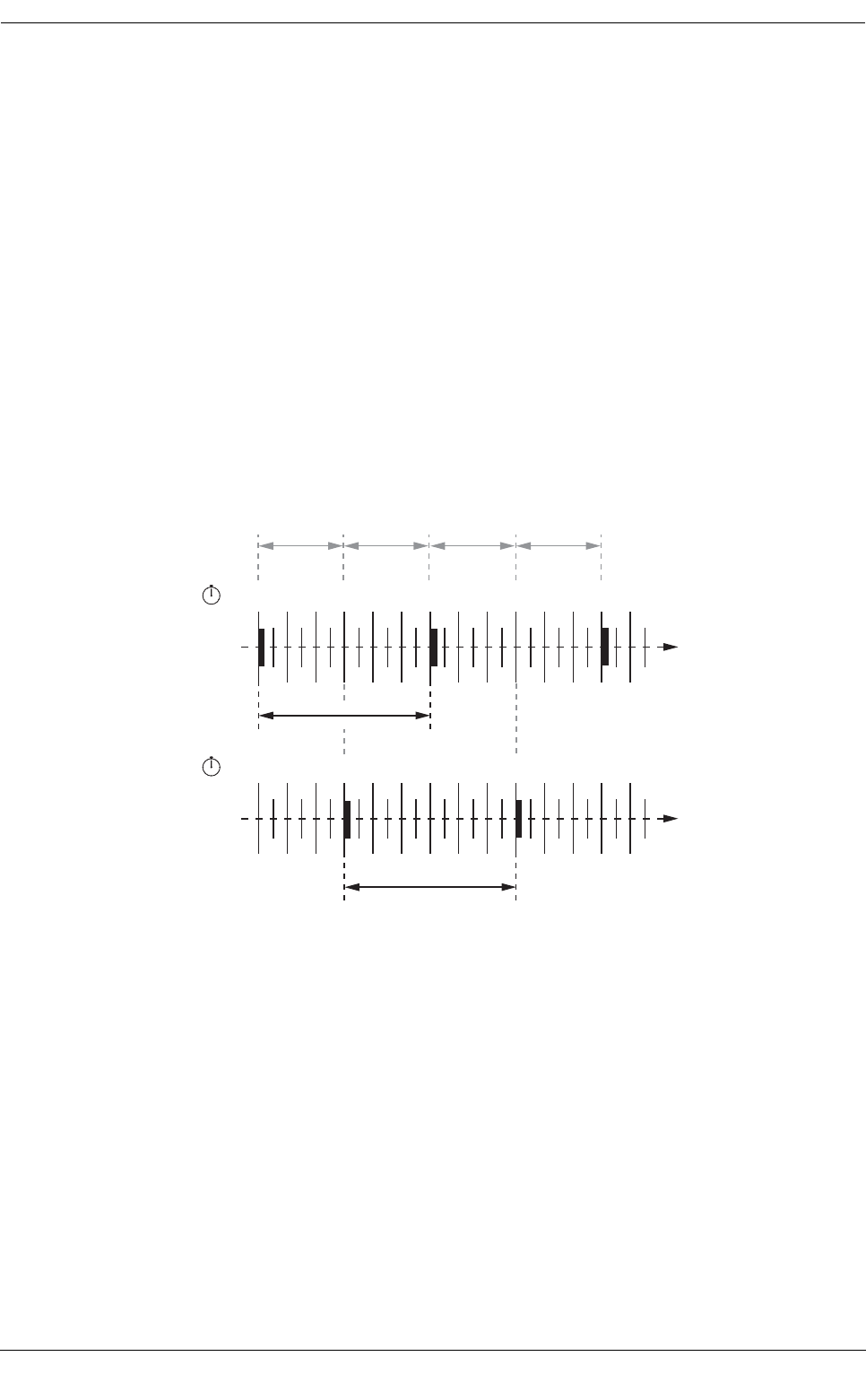
Configuration using proAtoN
Page 35
Channel 2 start UTC
This is the hour and minute for transmission on channel 2. This specifies the AIS frame (minute) within a day
in which the start slot for channel 2 resides. Typically the channel 2 start time is offset by 3 minutes from the
start time used for channel 1. With a 6 minute reporting interval on each channel this results in a transmission
every 3 minutes on alternating channels.
Channel 2 start slot
This is the slot number for the first transmission on channel 2. The slot number can range from -1 (transmission
disabled on this channel) to 2249. Note that each message #21 transmission occupies two slots and associated
base station slot reservations must therefore reserve two slots.
Channel 2 interval
This is the interval in slots between transmissions on channel 2. The interval can range from 0 to 3240000 slots,
which equates to an interval of one day. Typically the interval is set to 13500 slots (6 minutes) on each channel
which results in an overall interval of 3 minutes.
Example FATDMA schedule
A typical transmission schedule requires that the AIS AtoN transceiver transmit AIS message #21 every three
minutes on alternating channels. The transmission schedule is presented diagrammatically in Figure 19.
Figure 19 Example FATDMA schedule
This schedule can be configured using the following values:
●Channel 1 start UTC = 00:00 (the first frame of every hour)
●Channel 1 start slot = 0 (the first slot in the frame, so slots 0 and 1 are used by the message #21
transmission)
●Channel 1 interval = 13500 slots (this equates to a 6 minute interval as there are 2250 slots per
minute)
●Channel 2 start UTC = 00:03 (the third frame of every hour)
●Channel 2 start slot = 0 (the first slot in the frame, so slots 0 and 1 are used by the message #21
transmission)
●Channel 2 interval = 13500 slots (this equates to a 6 minute interval as there are 2250 slots per
minute)
Channel 1
00:01
00:02
00:03
00:04
00:05
00:06
00:07
00:08
00:09
00:10
00:11
00:12
00:00
hh:mm
Channel 1 interval
13500 slots (6 minutes)
Channel 2
00:01
00:02
00:03
00:04
00:05
00:06
00:07
00:08
00:09
00:10
00:11
00:12
00:00
hh:mm
Channel 2 interval
13500 slots (6 minutes)
Overall interval
7500 slots
(3 minutes)
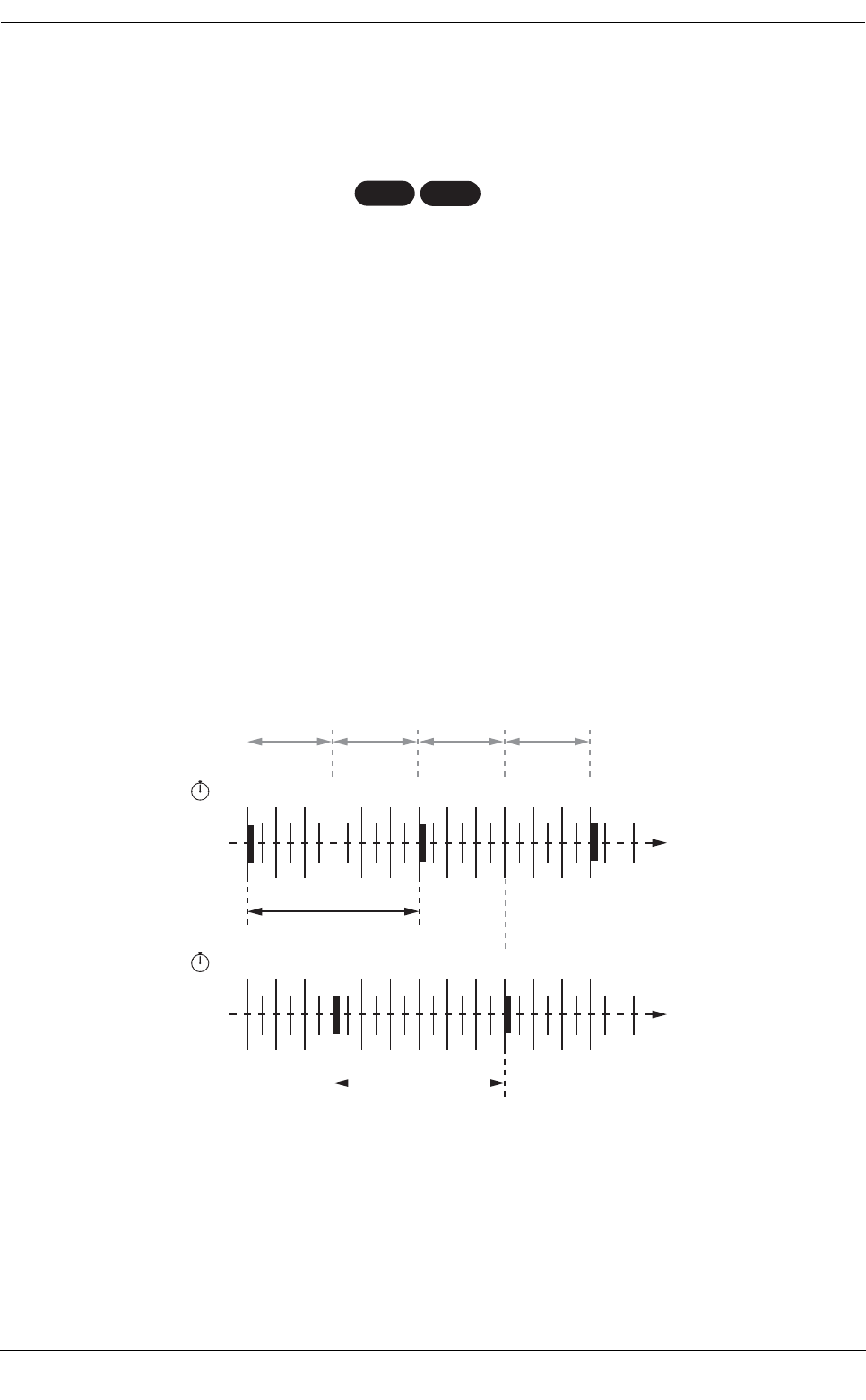
Configuration using proAtoN
Page 36
The transceiver is now configured to report message #21 on channel 1 every 6th minute, and on channel 2
every 6th minute, but offset by three minutes from channel 1. This results in a transmission of message #21
every three minutes on alternating channels. The actual start slot selected for each channel will depend on the
FATDMA allocations in the area of operation.
7.3.4 RATDMA Schedule configuration
Using the RATDMA (Random Access TDMA) access scheme the time for each transmission made by the
transceiver is specified. The transceiver will determine the actual slots used for transmission based on internal
knowledge of the AIS environment gained from the AIS receivers.
The parameters required for an RATDMA schedule are as follows.
Channel 1 start UTC
This is the hour and minute of the frame in which transmission will occur on channel 1. The slot used within this
frame will be determined by the transceiver.
Channel 1 interval
This is the interval in minutes between transmissions on channel 1. A typical value is 6 minutes.
Channel 2 start UTC
This is the hour and minute of the frame in which transmission will occur on channel 2. The slot used within this
frame will be determined by the transceiver.
Channel 2 interval
This is the interval in minutes between transmissions on channel 1. A typical value is 6 minutes.
Example RATDMA schedule
A typical transmission schedule requires that the AIS AtoN transceiver transmit AIS message #21 every three
minutes on alternating channels. The transmission schedule is presented diagrammatically in Figure 20.
Figure 20 Example RATDMA schedule
This schedule can be configured using the following values:
●Channel 1 start UTC = 00:00 (the first minute of every hour)
●Channel 1 interval = 6 minutes
●Channel 2 start UTC = 00:03 (the third minute of every hour)
●Channel 2 interval = 6 minutes
T3
T3+S
Channel 1
00:01
00:02
00:03
00:04
00:05
00:06
00:07
00:08
00:09
00:10
00:11
00:12
00:00
hh:mm
Channel 1 interval
6 minutes
Channel 2
00:01
00:02
00:03
00:04
00:05
00:06
00:07
00:08
00:09
00:10
00:11
00:12
00:00
hh:mm
Channel 2 interval
6 minutes
Overall interval
(3 minutes)
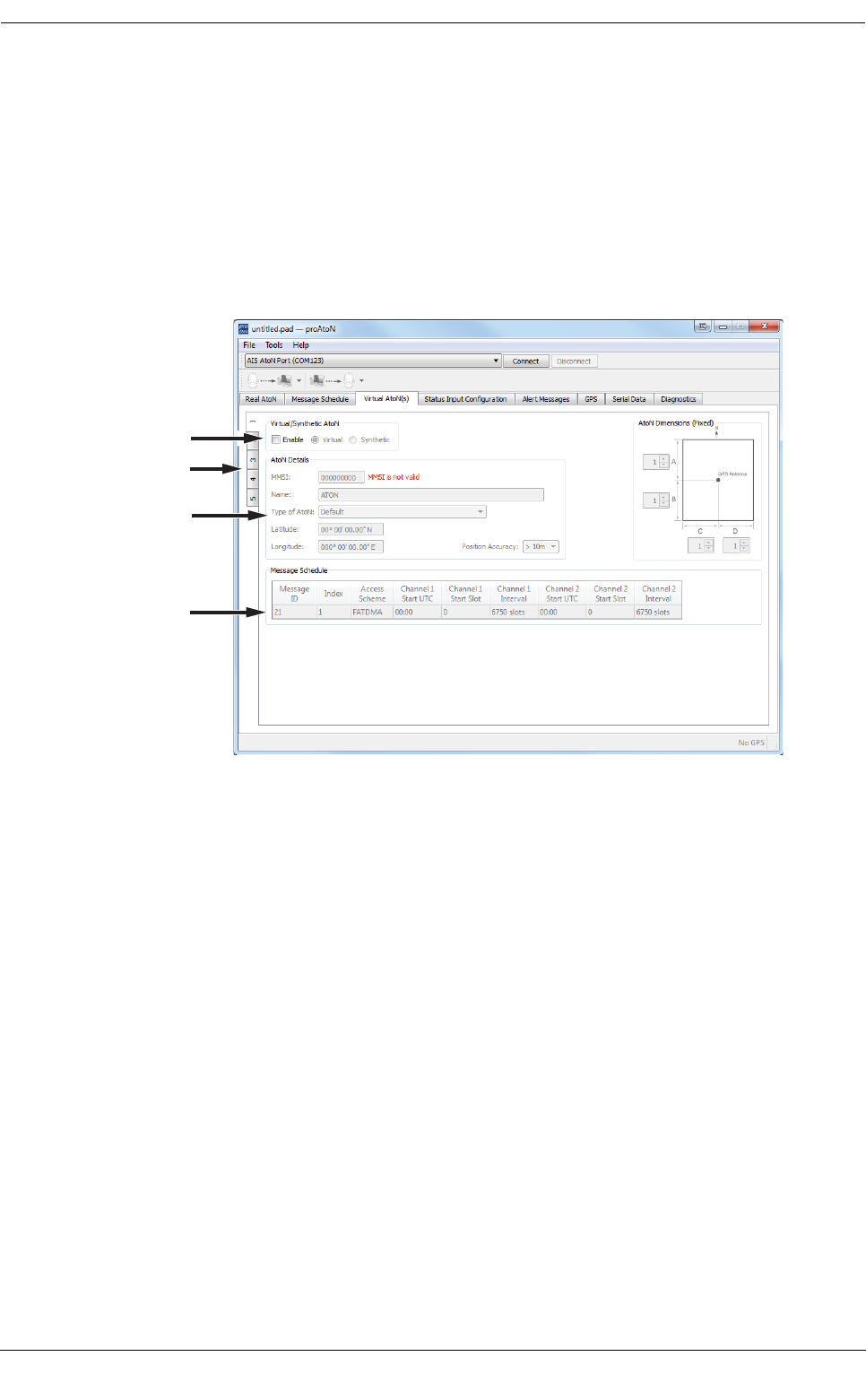
Configuration using proAtoN
Page 37
The transceiver is now configured to report message #21 on channel 1 every 6th minute, and on channel 2
every 6th minute, but offset by three minutes from channel 1. This results in a transmission of message #21
every three minutes on alternating channels. The exact timings of the transmissions within the selected minute
will vary as the transceiver selects available slots using RATDMA.
7.3.5 Virtual AtoN configuration
The transceiver can be configured to transmit position reports for up to five virtual or synthetic Aids to
Navigation. This configuration is carried out using the Virtual AtoN(s) tab in proAtoN. Within this tab there are
sub-tabs relating to each of the five virtual or synthetic AtoNs. The sub-tabs are visible at the left hand edge of
the window. The layout of the virtual AtoN configuration tab is provided in Figure 21.
Figure 21 Virtual AtoN configuration tab layout
The following parameters are required to configure a virtual or synthetic AtoN. Note that the ‘real’ AtoN must
be properly configured in order to make use of the virtual AtoN feature.
Virtual / Synthetic AtoN
Each virtual AtoN required must be separately enabled by checking the ‘Enable’ checkbox. The type of virtual
AtoN can then be selected.
●Virtual AtoN
A virtual AtoN is transmission of message #21 for an Aid to Navigation that does not physically exist.
A virtual AtoN may be used to mark a temporary hazard to navigation, e.g., a wreck. For further
information on the use of virtual AtoNs please refer to IALA A-126, IALA O-143 and IALA guideline
1081.
●Synthetic AtoN
A synthetic AtoN is transmission of message #21 from an AIS station located remotely from the
physical Aid to Navigation. An example of use is to provide an AIS AtoN target for a buoy or mark that
is not capable of supporting AIS AtoN hardware.
Virtual AtoN Details
The basic configuration of a virtual or synthetic AtoN is comparable to that required for a ‘real’ AIS AtoN. Note
that the MMSI number format is different:
●A virtual AtoN MMSI has the format 99MID6XXX, where MID is the appropriate national MID and XXX
is a number unique to this station.
Enable virtual AtoN
and select type
Virtual AtoN subtabs
Virtual AtoN details
Virtual AtoN schedule
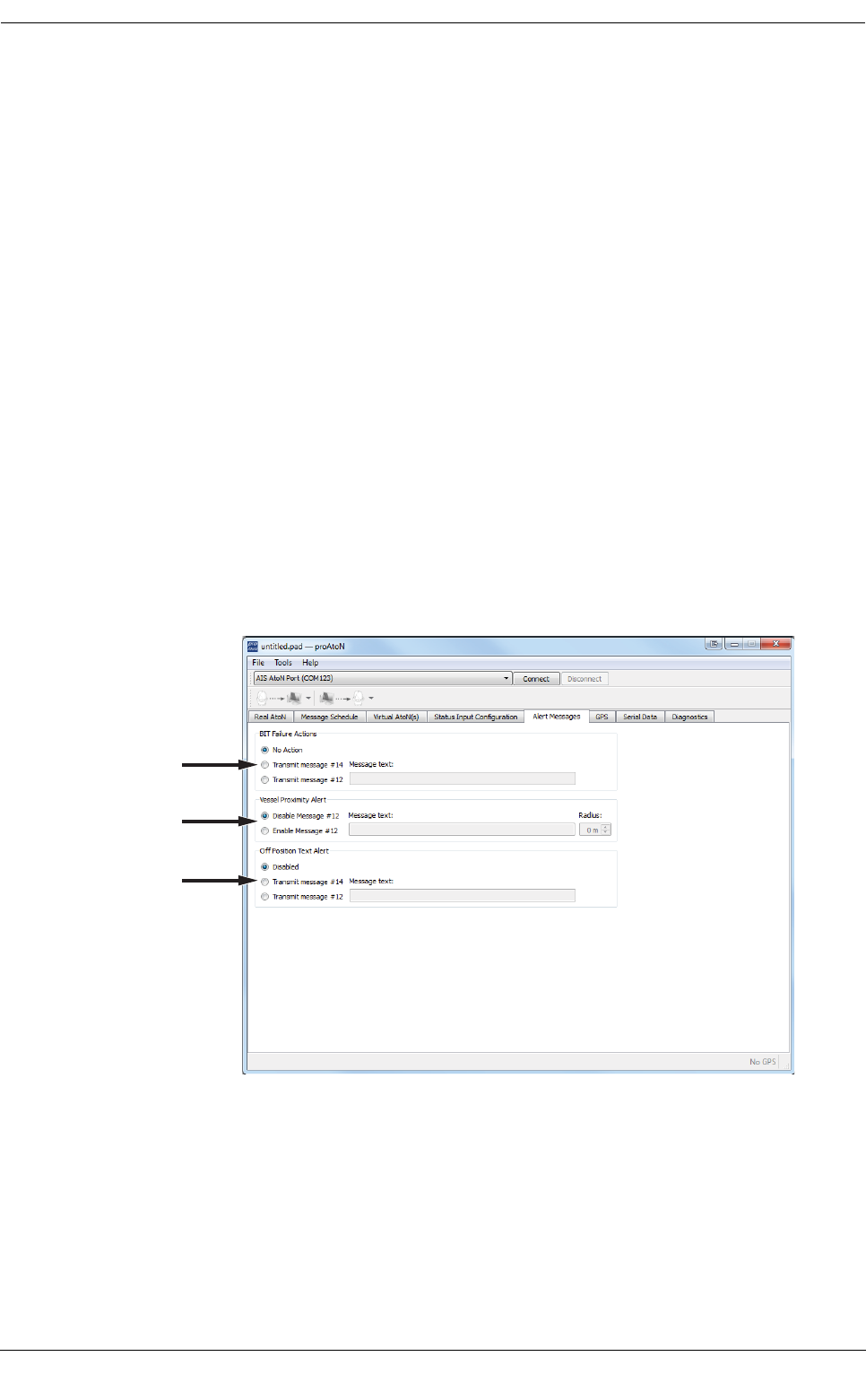
Configuration using proAtoN
Page 38
●A synthetic AtoN MMSI has the same format as a real AtoN MMSI, e.g., 99MID1XXX, where MID is
the appropriate national MID and XXX is a number unique to this station.
The position of the virtual or synthetic AtoN must be configured appropriately to the position of the aid. The
dimensions of the virtual or synthetic AtoN should also be configured.
Virtual AtoN schedule
The transmission schedule for a virtual or synthetic AtoN must be configured in the same way as that for the
‘real’ AtoN. The TDMA access scheme, start times and intervals must be configured in the virtual AtoN tab
following the guidance in section 7.3.3 or 7.3.4 as appropriate. When an FATDMA schedule is used it is
important to ensure the slot allocations used for the virtual and real AtoNs are different in every case. Also note
that two consecutive slots are used for each virtual AtoN report.
7.3.6 Alert messages
The transceiver can be configured to transmit text messages for three different alert conditions.
●An addressed or broadcast text message can be transmitted when the transceiver detects a Built In
Integrity Test (BIIT) failure.
●An addressed text message can be transmitted to an approaching vessel if the vessel comes within a
configurable distance of the transceivers location. This function is only available with Type 3 variants
and with full time receiver operation.
●An addressed or broadcast text message can be transmitted when the transceiver determines that it
is off position (see section 7.3.1). This message is in addition to use of the alternate schedule for off
position reporting (if the alternate schedule is enabled) and does not replace that function.
The layout of the alert messages configuration tab is provided in Figure 22.
Figure 22 Alert messages configuration tab layout
BIIT failure actions
This section allows configuration of the text message to be transmitted on detection of a Built In Integrity Test
failure (BIIT failure). Such a failure may indicate a problem with the transceiver and it may be prudent to warn
vessels not to rely on the information provided by the transceiver in this situation. Note that the health of the
transceiver is always transmitted as part of the standard Aids to Navigation position report (message #21),
however the status contained in that message may not be shown on all display systems.
The available actions on BIIT failure are:
Congure BIIT failure
message action
Congure vessel
proximity alert action
Congure additional
o position alert action

Configuration using proAtoN
Page 39
●No action - no message is transmitted on detection of a BIIT failure
●Transmit message #14. A broadcast text message is transmitted on detection of a BIIT failure. The
text content of the message must be defined in the ‘Message text’ box.
●Transmit message #12. An addressed text message is transmitted on detection of a BIIT failure. The
destination for the addressed message is configured on the ‘Real AtoN’ tab (see section 7.3.1)
In addition to configuration of the BIIT failure action a schedule for the associated message must be configured
in the ‘Message schedule’ tab.
●Message #14 Index 1 must be configured if the message #14 action is selected.
●Message #12 Index 1 must be configured if the message #12 action is selected.
Vessel proximity alert
This section allows configuration of the text message to be transmitted on detection of vessel breaching a
defined radius (or guard ring) around the transceiver. This message can be used to warn approaching vessels
of potential collision with the AtoN. The addressed message is automatically sent to all vessels that breach the
guard ring radius.
The available vessel proximity alert actions are:
●Disable message #12 - the vessel proximity alert function is disabled
●Enable message #12 - the function is enabled and the text content of the message to be transmitted
must be defined in the ‘Message text’ box. The guard ring radius for the proximity alert must also be
configured in the ‘Radius’ box; note that the value is set in metres.
In addition to configuration of the vessel proximity alert a schedule for the associated message must be
configured in the ‘Message schedule’ tab.
●Message #12 Index 2 must be configured if the message #12 action is selected.
Off position alert
This section allows configuration of the text message to be transmitted when the transceiver detects that it is
off position. The settings for off position detection are made on the ‘Real AtoN’ tab (see section 7.3.1). The
configuration of an alternate message #21 reporting schedule when off position is independent of the
configuration of this text alert.
The available off position alert actions are:
●Disabled - no text message is transmitted when the transceiver determines that it is off position
●Transmit message #14. A text message is broadcast when the transceiver detects that is off position.
The text content of the message must be defined in the ‘Message text’ box.
●Transmit message #12. An addressed text message is transmitted on detection of an off position
condition. The destination for the addressed message is configured on the ‘Real AtoN’ tab (see
section 7.3.1)
In addition to configuration of the vessel proximity alert a schedule for the associated message must be
configured in the ‘Message schedule’ tab.
●Message #14 index 2 must be configured if the message #14 action is selected
●Message #12 index 3 must be configured if the message #12 action is selected
7.3.7 Status input configuration tab
AIS AtoN position reports (message #21) contain status information encoded as a bit sequence. The status
bits contain the basic operational state of a connected lamp and RACON along with the overall health of the
transceiver itself. Connection of a lamp and/or RACON is optional and requires equipment with a suitable
health output. Interfacing of lamp and RACON status is described in sections 6.1.1, 6.1.3 and 6.2.4.
The status information can be obtained from one of three sources as described in section 6.1.3. The status
input configuration tab is used to set the source and other associated parameters. The layout of the status input
configuration tab is provided in Figure 23.
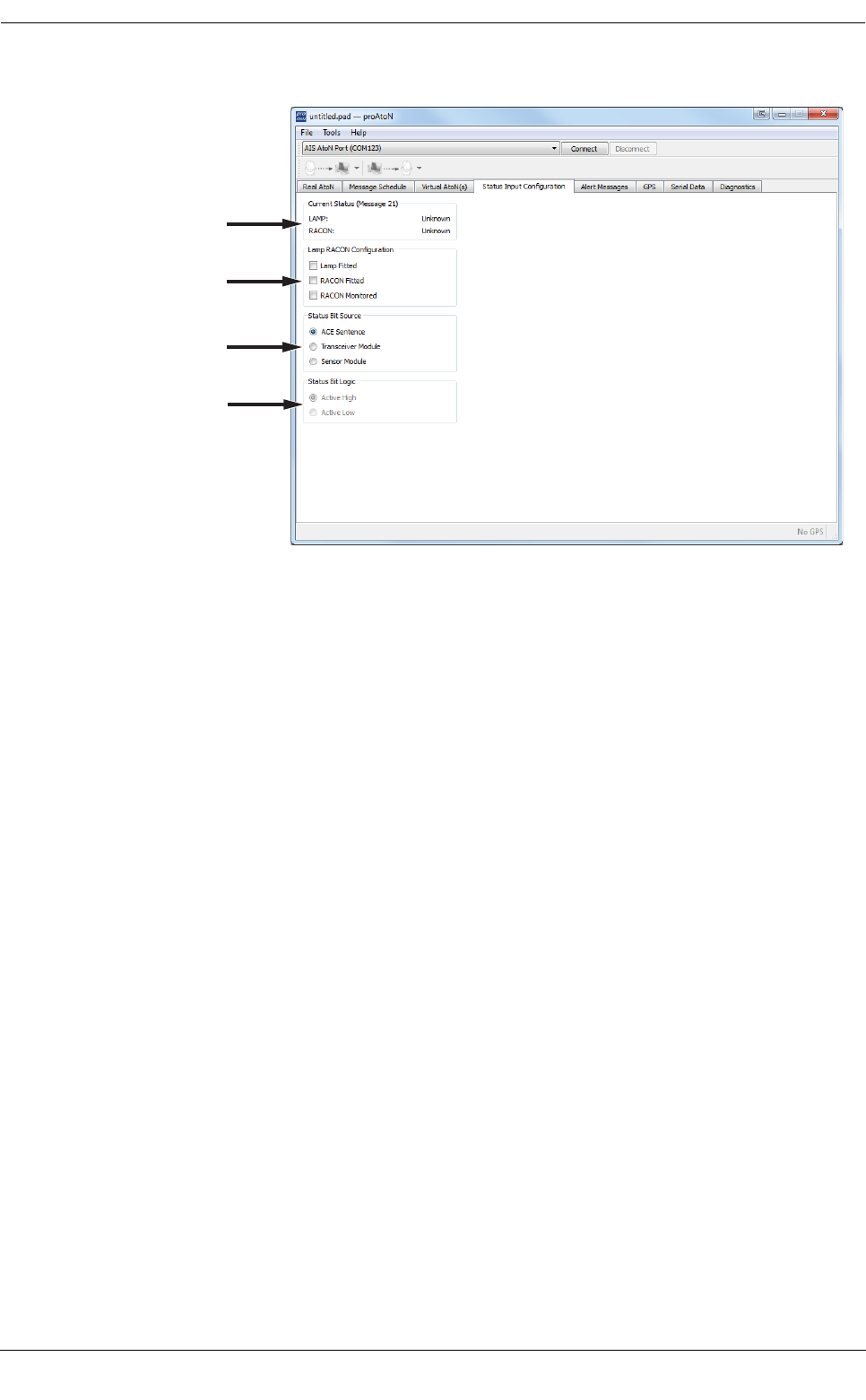
Configuration using proAtoN
Page 40
Figure 23 Status input configuration tab layout
Current status (message 21)
This section shows the current lamp and RACON status determined by the transceiver. The transceiver must
be connected and powered from a DC supply in order for this display to operate correctly.
Lamp & RACON configuration
This section allows the fixed parameters of the lamp and RACON to be configured. The check boxes should
be set according to the physical configuration. For example if a lamp status output is connected to the
transceiver then the ‘Lamp fitted’ check box should be checked. If a RACON is connected it is also possible to
define if the RACON is monitored or not.
Status bit source
Select the source for the status information to match the method used to provide status information to the
transceiver (this is described in section 6.1.3).
Status bit logic
The logical sense of the physical status bit inputs (at either the basic or extended sensor interfaces) can be set
here. This allows for interface of equipment with active high or active low status outputs.
7.4 Transceiver diagnostics
The proAtoN application provides a number of features to assist with installation of an AIS AtoN and diagnosis
of fault conditions. These features are available through the GPS, Diagnostics and Serial Data tabs in proAtoN.
7.4.1 GPS tab
The GPS tab shows the status of the GNSS receiver built into the transceiver. This provides an indication of
the quality of the GNSS satellite signals being received along with the current position of the transceiver.
At least four satellites with a carrier to noise ratio in excess of 40 dBHz are required for an acceptable position
fix. Relocating the transceiver or connecting an external GNSS antenna can help improve the signal quality
and resulting position accuracy.
Current status display
(when connected to transceiver)
Set xed status as installed
Set status bit source
Set status input logic

Configuration using proAtoN
Page 41
The internal GNSS receiver supports SBAS (Satellite Based Augmentation Service) to enable improved
accuracy and integrity of GNSS position fixes. The availability of SBAS depends on the installation location of
the transceiver (the WAAS SBAS service covers most of the US and the EGNOS service covers Europe).
7.4.2 Diagnostics tab
The Diagnostics tab provides system version and status information. This information may be required when
requesting technical support for the product.
AtoN Details
●The connected AtoN Type is displayed as Type 1 or Type 3
●The application and bootloader software versions for the connected AtoN are displayed
●The serial number of the connected AtoN is displayed
Power status
●The VHF antenna VSWR (Voltage Standing Wave Ratio) as measured at the last AIS transmission is
displayed. This value is for indication only. A value better than 3:1 is expected for a good antenna
system. The alarm limit for antenna VSWR is set to 5:1. A perfect antenna would give a VSWR of 1:1.
●The system supply voltage is displayed in volts. The supply voltage must be between 9.6V and 32.6V
for correct operation. The supply voltage alarm will activate outside of this supply voltage range.
Report generation
Clicking the ‘Generate’ button will produce full report of the transceiver status. This report may be requested
by technical support personnel. After clicking the button select a suitable location for the report file before
clicking save.
Reported messages
During operation the transceiver will output a variety of status messages relating to the current operating state.
These messages are for information only and do not represent a fault condition.
Message text Description / Resolution
TX attempt failed
(msg 6 no payload re-broadcast data)
A transmission of message #6 has failed as the
payload data required for this message was not
provided (by either the extended sensor interface, or
an external system). The likely cause is a
configuration error relating to data capture.
TX attempt failed
(msg 8 no payload re-broadcast data)
A transmission of message #8 has failed as the
payload data required for this message was not
provided (by either the extended sensor interface, or
an external system). The likely cause is a
configuration error relating to data capture.
TX attempt failed
(msg 12 no payload re-broadcast data)
A transmission of message #12 has failed as the
payload data required for this message was not
provided (by either the extended sensor interface, or
an external system). The likely cause is a
configuration error relating to data capture.
TX attempt failed
(msg 14 no payload re-broadcast data)
A transmission of message #14 has failed as the
payload data required for this message was not
provided (by either the extended sensor interface, or
an external system). The likely cause is a
configuration error relating to data capture.

Configuration using proAtoN
Page 42
Active alarms
The transceiver incorporates BIIT (Built In Integrity Test) routines which continuously monitor key operating
parameters. Should an integrity test fail the failure will be indicate in the active alarms area.
Standby blocked: Off position algorithm The transceiver can’t enter standby (low power) mode
because the ‘off position’ algorithm has detected an
off position condition. Moving the transceiver within
the configured operating radius will resolve this.
Standby Blocked: Acquiring GPS The transceiver can’t enter standby (low power) mode
because it is currently acquiring a GNSS position fix.
Standby operation will resume when a fix is acquired.
Standby disabled Standby mode (low power operation) is disabled by
configuration.
Standby Blocked: USB connected The transceiver will not enter standby (low power)
mode whilst the USB interface is connected to a PC.
Standby Blocked: Shell running The transceiver will not enter standby (low power)
mode whilst the configuration shell is active.
Standby Blocked: Receivers enabled The transceiver can’t enter standby mode if the
current configuration requires that the receivers are
active.
Exiting standby Information only on exit of standby mode.
Entering standby for xx seconds Information only on entry to standby mode.
Alarm text Description / Resolution
Tx Malfunction A transmitter malfunction has been detected - please
contact your supplier.
Antenna VSWR exceeds limits The VHF antenna VSWR is above the permitted limit.
Check the VHF antenna, cable and connections are
sound. The VSWR measured at the last transmission
is displayed on the proAtoN diagnostics tab.
Rx Channel 1 malfunction A receiver malfunction has been detected - please
contact your supplier.
Rx Channel 2 malfunction A receiver malfunction has been detected - please
contact your supplier.
EPFS failure No position is available from the internal GNSS
receiver - please contact your supplier.
DGNSS input failed No data is available from the external source of
differential GNSS correction data. Please check
connections, baud rate and equipment configuration.
Message text Description / Resolution

Configuration using proAtoN
Page 43
7.4.3 Serial data tab
The serial data page shows all data output from the transceiver in NMEA0183 / IEC61162-1 format. It is also
possible to send NMEA0183 / IEC61162-1 commands to transceiver if required for technical support or custom
configuration. A facility to record the data to a file is provided by clicking the ‘Log to File’ button.
Certain sentence types can be filtered out of the output window by checking the relevant sentence type in the
‘Filters’ section of this tab.
7.5 Other features
The proAtoN application provides the following additional features to support transceiver installation and
upgrade.
7.5.1 Offline configuration
A complete AtoN configuration including all schedule parameters, virtual AtoN configuration and other settings
can be saved to a file. This feature allows a configuration file to be created without access to the transceiver
hardware. The file can be loaded at a later time and synchronised with the transceiver hardware.
This feature is available using the ‘Save File’ and ‘Load File’ items available on the File menu. The configuration
is saved as a .pad file using a format proprietary to the proAtoN application.
When the proAtoN application is launched a new blank configuration file is created. You will be prompted to
save this file if changes are made without saving the file prior to closing the application, or if a ‘New file’ is
created from the File menu.
7.5.2 Upgrade to Type 3 AtoN
This option is available in the ‘Tools’ menu and can be used to upgrade a Type 1 transceiver to a Type 3
transceiver following purchase of an upgrade key from your dealer. Please contact your dealer to purchase an
upgrade key; you will be required to provide the transceiver serial number displayed on the diagnostics tab.
Supply voltage The transceiver power supply voltage is outside of the
permitted range. The measured supply voltage is
displayed on the proAtoN diagnostics tab.
Low forward power The transmitter forward power is below a preset limit -
please contact your supplier.
Synchronisation lost Timing information is not available from the internal
GNSS receiver - please contact your supplier.
Alarm text Description / Resolution

Operation
Page 44
8 Operation
Once configured and connected to a power supply and antennas the transceiver will operate autonomously.
Correct operation can be confirmed by checking for reception of Aids to Navigation reports (message 21) using
another AIS device.
8.1 Standby operation
During operation the transceiver will enter a low power standby mode between scheduled transmissions. The
unit will not enter standby mode under the following conditions.
●USB interface connected - the transceiver will not enter standby mode whilst the USB interface is
connected to a PC. The USB interface should be disconnected once the AtoN is configured and
deployed.
●GPS acquisition - the transceiver will not enter standby mode for the first 12 minutes of operation with
GPS position available after power is first applied. This period is used to acquire the current number
of UTC leap seconds from the GPS system. This only occurs at initial power up and subsequently on
four occasions during each calendar year when it is possible for the number of leap seconds to
change.
●Off-position algorithm - the transceiver will not enter standby mode when the off position algorithm is
active and the transceiver is determined to be off position. Whilst off position the GPS receiver is
permanently enabled in order to monitor the position according to the algorithm provided in IALA
A-126 Annex A1. Should the transceiver return on position standby operation will resume
During operation the transceiver will output AITXT sentences to the NMEA0183 port 1 indicating any conditions
blocking entry to standby mode.
T1 T1+S
T3
T3+S
!
If entry into standby mode is blocked by one or more of these conditions the power
consumption of the transceiver will increase significantly.

Data messages and data sources
Page 45
9 Data messages and data sources
The transceiver can be configured to transmit a range of data messages in addition to the standard AIS AtoN
position report. The purpose, content and means of configuring supported message types is described in the
table below.
Configuration of the AtoN for capture of data for messages #6 and #8 is described in the following sections.
The options available for data capture depend on the transceiver variant.
9.1 Product variants without the extended sensor interface
The data payload for binary messages #6 or #8 must be provided by external equipment interfaced to the
transceiver using the transceiver NMEA0183 port 1 available at the Power and transceiver interface connector
described in section 5.5.1. The payload data for the message is requested by the transceiver using a
proprietary MCR sentence and provided by the external equipment using the MPR sentence defined in section
10.2.10. Full detail of the protocol for interface of external equipment using this interface is available in an
application note “Interfacing third party sensor interfaces” which is available on request from your supplier.
ID Message
type Description and use Content sources
6 Addressed
binary data
This message is addressed to another
individual AIS station, usually an AIS base
station, which is configured to decode the
message content. The message content is
binary data in a standardised or proprietary
format. The message may be used to
communicate status information about the
AtoN and / or metrological and hydrological
data captured at the AtoN.
The binary content for this
message can be generated by
the extended sensor interface,
or provided by suitably
configured third party
equipment. See sections 9.1
and 9.2 for further information.
8 Broadcast
binary data
This message is broadcast to all other AIS
stations. The message content is binary data in
a standardised or proprietary format. The
message may be used to communicate status
information about the AtoN and / or
metrological and hydrological data captured at
the AtoN.
The binary content for this
message can be generated by
the extended sensor interface,
or provided by suitably
configured third party
equipment. See sections 9.1
and 9.2 for further information.
12 Addressed
safety
related
message
This message is addressed to another
individual AIS station and contains safety
related text. The text can warn of a failure of
the AtoN equipment, alert an approaching
vessel to danger of collision with the AtoN or
indicate that the AtoN is operating off position
See section 7.3.6 for further
information.
14 Broadcast
safety
related
message
This message is broadcast to all other AIS
stations and contains safety related text. The
text can warn of a failure of the AtoN
equipment or indicate that it is operating off
position
See section 7.3.6 for further
information.
T1
T3

Data messages and data sources
Page 46
9.2 Variants with the extended sensor interface
The extended sensor interface provides a wide range of input and output capabilities as listed in section 6.2.
The transceiver is supplied ready with direct support for a specific set of external sensing equipment and AtoN
status inputs. The extended sensor interface can also be adapted through software changes to support almost
any equipment that might be encountered in an AtoN application. If your application requires interface to
equipment other than that listed here please contact your supplier to discuss your requirements.
The default configuration of the extended sensor interface provides:
●Data for message #8, DAC 001, FI 31 for IMO Metrological and Hydrological data
○Metrological data is captured from an Airmar PB200 weather station
○Hydrological data is captured from an Impress Sensors & Systems S12C pressure and
temperature sensor (SDI-12 interface sensor)
●Data for message #6, DAC 235, FI 10 for UK GLA AtoN monitoring message
○Data is captured from voltage measurements and other inputs to the extended sensor interface
○See IALA A-126, Annex C, Example 1 for the definition of this message structure
9.2.1 Configuration for message #8 (DAC 001, FI 31) for Metrological and Hydrological data
In order to transmit this message the transceiver must be appropriately configured and interfaced to compatible
sensors which are also configured as described below.
Transceiver configuration
The transceiver must be configured with a schedule for message #8 index 1.
●The schedule can be either FATDMA or RATDMA. The recommended interval for this message is 12
minutes (27000 slots). Configure the transceiver with a schedule for message #8 index 1 using
proAtoN following the guidance in section 7.3.2.
●Note that each message #8 FI 31 occupies two slots.
●In order for the sensors to be detected and configured appropriately they must be connected to the
transceiver and powered prior to application of power to the transceiver.
Airmar PB200 Weather station connection
Metrological information is collected by an Airmar PB200 weather station connected to the transceiver
extended sensor interface. The NMEA0183 interface variant of the PB200 weather station is required.
The installation must provide a suitable power supply (and optional heater power supply) for the PB200
weather station as this is not provided by the transceiver. Please refer to Airmar product documentation for
power supply requirements.
The wiring information below relates to the NMEA0183 cable description in revision 06 of the PB200 installation
instructions. Please confirm the signal names and wiring colours with the latest installation guide supplied with
the PB200 prior to connection. The sensor is connected to the extended sensor interface NMEA0183/RS422
port available at the transceiver sensor interface connector X.
Transceiver sensor
interface connector X pin
and function
Signal description
PB200
NMEA0183
cable wire
colour
PB200
pin
number
PB200
signal
name
D (S_RS422_TX1_A) Data from transceiver to sensor Yellow 7 A/+ IN
E (S_RS422_TX1_B) Data from transceiver to sensor Orange 8 B/- IN
F (S_RS422_RX1_A) Data from sensor to transceiver White 3 A/+ OUT
G (S_RS422_RX1_B) Data from sensor to transceiver Blue 9 B/- OUT
T1+S
T3+S
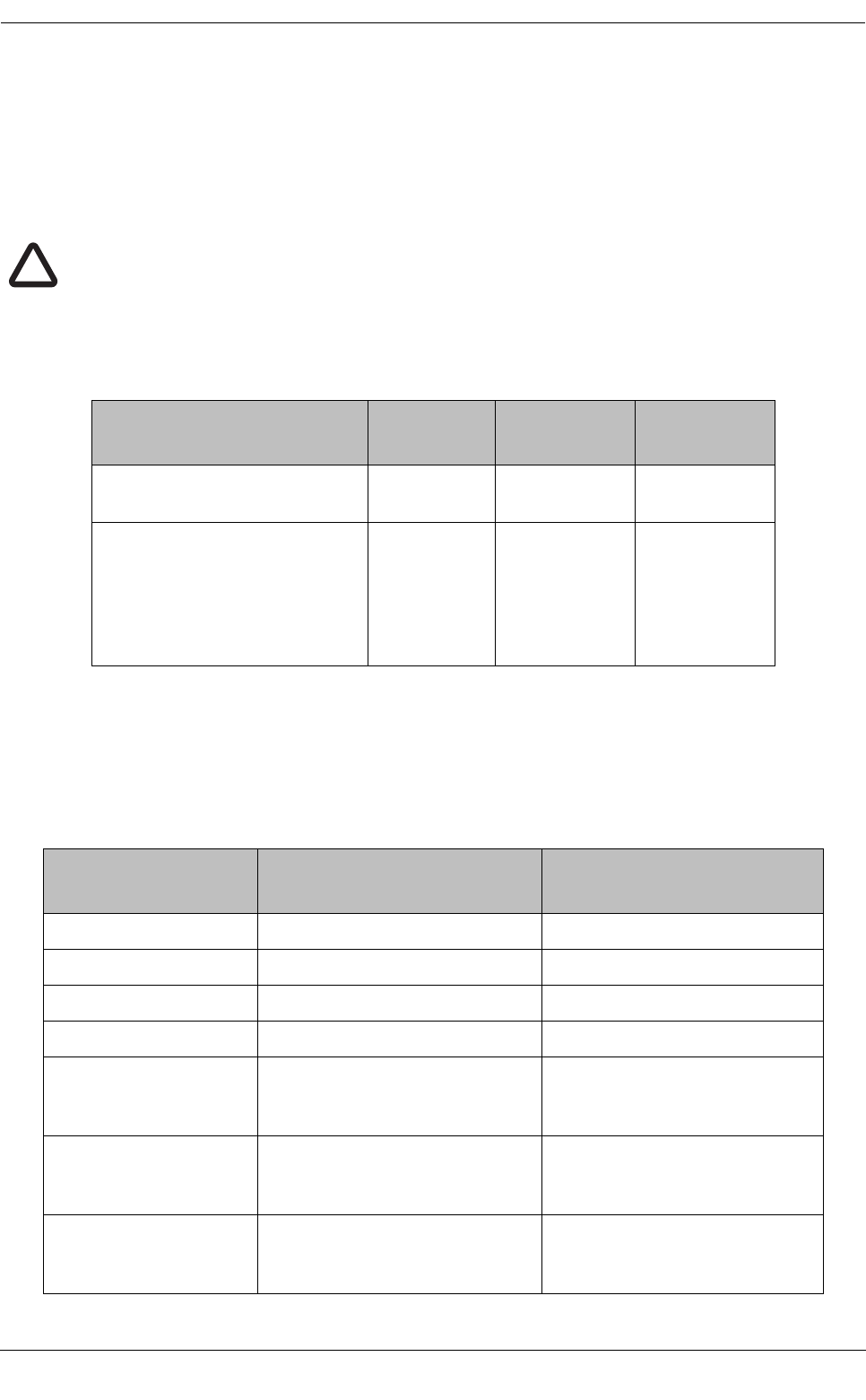
Data messages and data sources
Page 47
Impress S12C pressure and temperature sensor connection
Water pressure (depth / tide level) and temperature are collected by an Impress Sensors & Systems S12C
sensor connected to the transceiver extended sensor interface. The S12C sensor communicates using an
SDI-12 bus data interface (see section 6.2.8 for further information).
The installation must provide a suitable power supply for the SDI-12 bus as this is not provided by the
transceiver. Please refer to the S12C sensor documentation for power supply requirements.
The sensor is connected to the extended sensor interface SDI-12 port available at the transceiver sensor
interface connector Y. A ground for the SDI-12 bus is also required and this may be obtained at any one of the
GND pins listed in the tables.
Impress S12C pressure and temperature sensor configuration
The SDI-12 bus address of the S12C sensor must be configured as zero (the default address) in order for it to
be detected by the transceiver.
Data mapping for message #8 (DAC 001, FI 31) for Metrological and Hydrological data
The mapping of data collected by the sensors to the message #8 FI 31 data fields is provided in the table below.
Transceiver sensor interface
connection
Signal
description
S12C sensor
wire colour
S12C signal
name
Sensor interface connector Y,
Pin E (SDI_DATA)
SDI-12 bus
data line
Yellow SDI-12 output
Sensor interface connector X,
Pin T (GND)
Or
Power and transceiver interface
connector Pin N or S
GND
Connect also
to SDI-12
bus supply
GND
Blue Supply- (0V)
Message #8 FI 31 data
field Data source Notes
Longitude Transceiver internal GNSS
Latitude Transceiver internal GNSS
Position accuracy Transceiver internal GNSS
Time stamp Transceiver internal GNSS
Average wind speed Airmar PB200 weather station
WIMWD wind speed output
The wind speed provided by the
sensor is averaged over 10
minutes before output
Wind gust Airmar PB200 weather station
WIMWD wind speed output
This value is the peak wind
speed recorded during the
previous 10 minute period
Wind direction Airmar PB200 weather station
WIMWD wind direction output
The wind direction provided by
the sensor is averaged over 10
minutes before output
!
The wiring information below relates to the cable description provided with the S12C sensor at
the time of writing. Please confirm the signal names and wiring colours with the latest
installation guide supplied with the S12C prior to connection.

Data messages and data sources
Page 48
Wind gust direction Airmar PB200 weather station
WIMWD wind direction output
The direction of the wind at the
peak wind speed during the
previous 10 minute period
Air temperature Airmar PB200 weather station
WIMDA air temperature output
The air temperature provided by
the sensor is averaged over 10
minutes before output
Relative humidity NA Data not provided
Dew point NA Data not provided
Air pressure Airmar PB200 weather station
WIMDA barometric pressure
output
The barometric pressure
provided by the sensor is
averaged over 10 minutes
before output
Air pressure tendency Airmar PB200 weather station
WIMDA barometric pressure
output
The air pressure is monitored
over a 30 minute period and
‘steady’, ‘increasing’ or
‘decreasing’ tendency reported
as appropriate
Horizontal visibility NA Data not provided
Water level IMPRESS S12C sensor water
level
Water level averaged over the
data reporting interval specified
for this message.
Water level trend NA Data not provided
Surface current speed NA Data not provided
Surface current
direction
NA Data not provided
Current speed #1, #2
and #3
NA Data not provided
Current direction #1, #2
and #3
NA Data not provided
Current measuring level
#1, #2 and #3
NA Data not provided
Significant wave height NA Data not provided
Wave period NA Data not provided
Wave direction NA Data not provided
Swell height NA Data not provided
Swell period NA Data not provided
Swell direction NA Data not provided
Sea state NA Data not provided
Water temperature IMPRESS S12C sensor water
temperature
Current temperature reported by
the sensor
Message #8 FI 31 data
field Data source Notes

Data messages and data sources
Page 49
9.2.2 Configuration for message #6, DAC 235, FI 10 for UK GLA AtoN monitoring message
In order to transmit this message the transceiver must be appropriately configured and interfaced to
appropriate signals as described below.
Transceiver configuration
The transceiver must be configured with a schedule for message #6 index 1.
●The schedule can be either FATDMA or RATDMA. The recommended interval for this message is 12
minutes (27000 slots). Configure the transceiver with a schedule for message #6 index 1 using
proAtoN following the guidance in section 7.3.2.
●The destination MMSI for addressed messages must also be configured as described in section
7.3.1. This should be the MMSI of a shore station that will receive and display the monitoring
message
●Note that each message #6 FI 10 occupies one slot.
Data mapping for #6, DAC 235, FI 10 for UK GLA AtoN monitoring message
The data mapping from the extended sensor interface inputs to the message #6 FI 10 fields is defined in the
following table.
Precipitation (type) NA Data not provided
Salinity NA Data not provided
Ice NA Data not provided
Message #6 FI 10 data
field Data source Notes
Analogue voltage
(internal)
Supply voltage to the transceiver No additional connections are
required for this measurement
Analogue voltage
(external 1)
Extended sensor interface
isolated analogue input 1
See pin allocation in section
5.5.4 and input description in
section 6.2.1
Analogue voltage
(external 2)
Extended sensor interface
isolated analogue input 2
See pin allocation in section
5.5.4 and input description in
section 6.2.1
Status bits (internal, 5
bits)
Copy of status bits used in
message #21
See section 7.3.7 for information
on configuration of status
source.
Status bits (external, 8
bits)
Bit 0 - Isolated digital input 1
Bit 1 - Isolated digital input 2
Bit 2 - Isolated digital input 3
Bit 3 - Isolated digital input 4
Bit 4 - Isolated digital input 5
Bit 5 - Set to 1 if lamp current
sense >=100mA, else set to 0
Bit 6 - non isolated digital input 1
Bit 7 - non isolated digital input 2
See sections 5.5.3 and 5.5.4 for
pin allocations and sections
6.2.3, 6.2.4 and 6.2.5 for
descriptions of these inputs.
Off position status Transceiver off position algorithm No additional connections are
required for this measurement
Message #8 FI 31 data
field Data source Notes
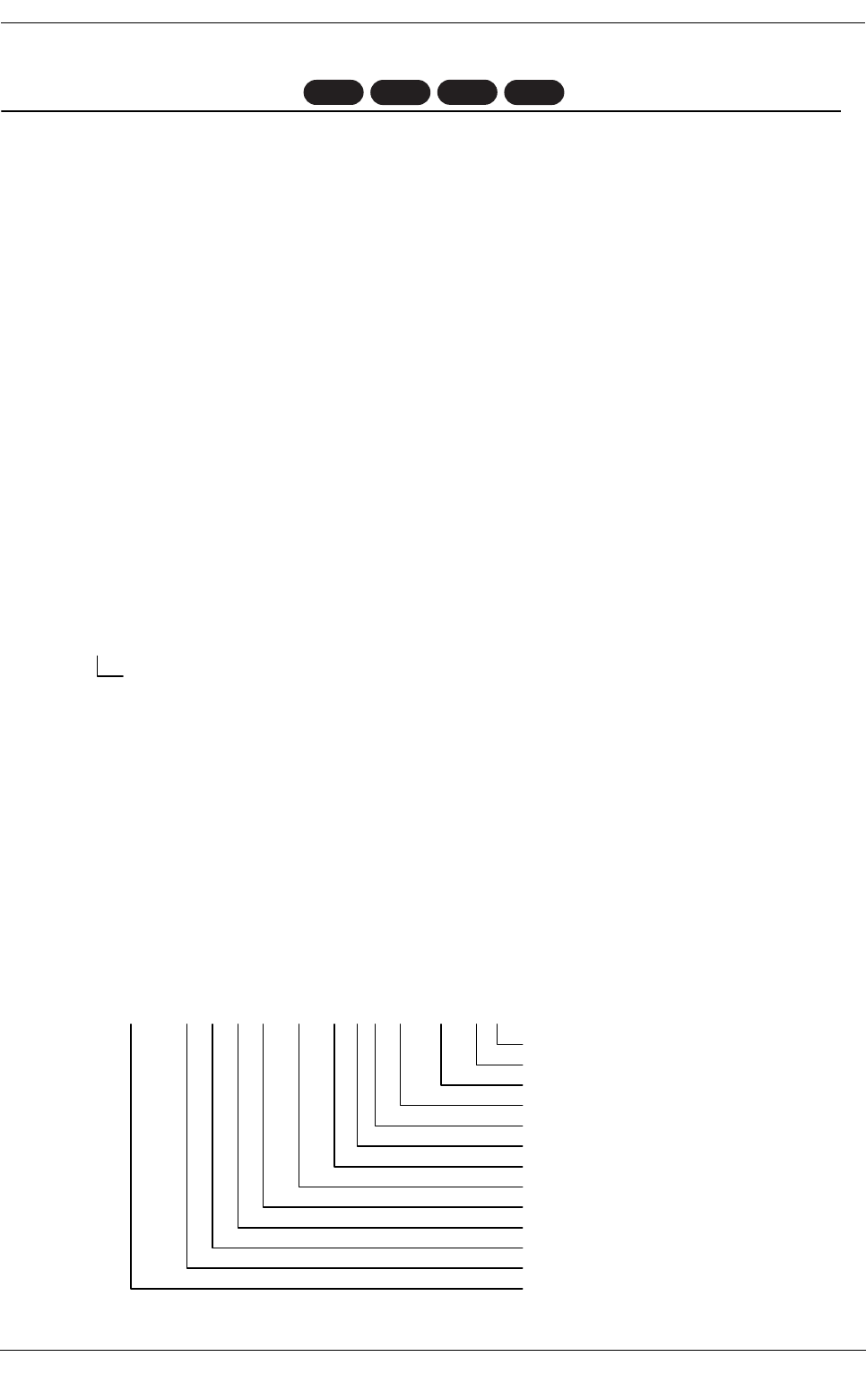
Manual configuration
Page 50
10 Manual configuration
The transceiver is configured using standardised NMEA0183 (IEC61162-1/2) sentences developed for
configuration of AIS Aids to Navigation transceivers.
10.1 Basic Type 1 AIS AtoN configuration (FATDMA operation)
The following information is the minimum required configuration for a Type 1 AIS AtoN reporting message #21
only.
●The AtoN station must be configured with the 'real' AtoN MMSI using the AID command.
●The AtoN station must be configured with an Name, Charted position, operating radio channels and
dimensions using the ACF and ACE commands.
●The AtoN should be configured to broadcast message 21 using the AAR command. Note that the
slots selected for the AIS AtoN transmissions in FATDMA mode must be reserved by a base station
operating in the area in which the AIS AtoN will be deployed.
10.2 NMEA0183 / IEC61162 configuration sentences
The following section documents the standardised NMEA0183/IEC61162 sentences used for AIS AtoN
configuration and control.
Please refer to IEC61162-1 (Edition 4) for complete details of the configuration sentence structure.
The configuration sentence formats described in this section are used to both configure the device and as the
response format from the device when queried for current status. The query command format is as follows:
For example the query command $ECAIQ,AAR*21 requests the transceiver output an AAR sentence
containing the currently configured broadcast rates for the AtoN station.
Configuration sentences are communicated using the transceiver USB interface.
10.2.1 AAR - Configure broadcast rates for AtoN station
This sentence assigns the schedule of slots that will be used to broadcast Message 21 and other allowed AIS
AtoN Station messages. It provides the start slot and interval between the slots used for consecutive
transmissions for the message. The AIS AtoN Station should apply the information provided by this sentence
to autonomously and continuously transmit the VDL messages until revised by a new AAR sentence. The AIS
AtoN Station, upon receipt of an AAR Query for this information, will generate sentences for configured
messages providing the current broadcast schedule. New AAR assignments will override existing AAR
assignments.
T1 T1+S
T3
T3+S
$--AIQ
,
ccc
*hh<CR><LF>
Sentence formatter of data being requested
(
e.g.,AAR)
$--AAR,xxxxxxxxx,xx,xx,xx,xx,xxxx,x.x,x,xx,xx,xxxx,x.x,a*hh<CR><LF>
Sentence status flag (see note 7)
Slot interval channel 2 (see note 6)
Start slot channel 2 (see note 5)
UTC minute for channel 2
UTC hour for channel 2
FATMA or RATDMA setup (see note 4)
Slot interval channel 1 (see note 6)
Start slot channel 2 (see note 5)
UTC minute for channel 2
UTC hour for channel 2
Message ID index (see notes 3 & 8)
Message ID (see note 2 & 8)
MMSI (see notes 1 & 8)

Manual configuration
Page 51
10.2.2 ACE - Extended general AtoN Station configuration
This sentence and the ACF sentence are used to configure the AtoN Station parameters when it is initially
installed, and later in order to make changes to the way it operates. This sentence supports system
administration of the AIS AtoN Station operation.
Note 1 The MMSI is defined in the AID sentence. This field contains the linkage between the MMSI definition (AID),
Message 21 configuration (ACF, and ACE) and scheduling (AAR) of Message 21 transmissions.
Note 2 Message ID is the message identification of the message being scheduled. When Message ID is 0 this indicates
that the slots being defined will be used for chaining messages. These slots are not reserved on the VDL via a
Message 20 until the competent authority requires their use and will reserve the slots at that time for the proper
duration. These slots can be used for chaining or for MPR single transmission.
Note 3 Message ID Index is used when there are multiple versions of a Message ID. This index value should start at 1.
Note 4 Used to select whether the AAR is configuring an FATDMA schedule or RATDMA/CSTDMA schedule (0 indicates
FATDMA, 1 indicates RATDMA)
Note 5 For all messages which need to be transmitted in FATDMA mode, starting slot ranging from −1 to 2249 should be
used. A value of –1 discontinues broadcasts of the message when the AAR sentence is sent to the AtoN Station,
and indicates that no message has been broadcast if the AAR sentence is received from the AtoN Station. A null
field indicates no change to the current start slot setting when sent to the AtoN Station, and indicates that the start
slot has not been set, i.e. is unavailable, when the AAR sentence is received from the AtoN Station. For an
RATDMA transmission schedule, this field will be Null.
Note 6 For all messages which need to be transmitted, in FATDMA mode slot Interval ranging from 0 to (24*60*2250;once
per day) and in RATDMA/CSTDMA mode, time interval ranges from 0 to (24*60*60) s. A null field indicates no
change to the current slot interval setting when sent to the AtoN Station, and indicates that the slot interval has not
been set, i.e. is unavailable, when the AAR sentence is received from the AtoN Station.
Note 7 This field is used to indicate a sentence that is a status report of current settings or a configuration command
changing settings. This field should not be null.
“R’ = sentence is a query response
“C” = sentence is a configuration command to change settings.
Note 8 The MMSI/Message ID/Message ID index are used to reference a table of messages loaded using MPR,
ACF/ACE; this sentence defines the broadcast schedule for each message. Each message in this table is
referenced by the combination of MMSI, Message ID, and Message ID index.
Note 1 AtoN status bits, indication of the AtoN status, default “00hex”: for a Virtual AtoN, this field should be
00hex. The three most significant bits represent the page ID.
Note 2 The off-position indicator is generated when this threshold is exceeded (distance in metres).
Note 3 Determines the behaviour of AtoN for message acknowledgement (Message 7 and 13):
0 will provide acknowledgement as defined by manufacturer,
1 will not provide acknowledgement.
Note 4 Off-position behaviour:
0 – maintain current transmission schedule,
1 – use new reporting interval configured by AAR using message ID index.
Note 5 Synch lost behaviour:
0 – silent,
1 – continue as before.
Note 6 Name of the AtoN: maximum 34 characters.
Note 7 Reference point of reported position; should be given as dimension (aaabbbccdd) of the buoy.
(See IALA A-126)
Sentence status flag (see note 8)
Dimensions (see note 7)
Name of AtoN (see note 6)
Synch lost behaviour (see note 5)
Off position behaviour (see note 4)
A
cknowledgment procedure (see note 3)
Off position threshold (see note 2)
A
toN status bits (see note 1)
MMSI
$--ACE,xxxxxxxxx,hh,xxxx,x,x,x,c--c,xxxxxxxxxx,a,*hh<CR><LF>

Manual configuration
Page 52
10.2.3 ACF - General AtoN Station configuration
This sentence and the ACE sentence are used to configure Message 21 content for the AtoN
Station and all of the Synthetic/Virtual AtoN Stations associated with the AtoN Station.
10.2.4 AFB - Forced broadcast
This sentence is used to force a transmission of the indicated VDL message, this message is already known
to the AIS AtoN Station through AAR/MPR or ACE/ACF/AAR configuration commands.
Note 8 This field is used to indicate a sentence that is a status report of current settings or a configuration command changing
settings. This field should not be null.
“R’ = sentence is a query response,
“C” = sentence is a configuration command to change settings.
Note 1 Identifies the source of the position, see ITU-R M.1371 Message 21 parameter (type of electronic position fixing
device).
Note 2 Nominal or charted position.
Note 3 0 = low > 10 m,
1 = high < 10 m; differential mode of DGNSS. VHF channel number, see ITU-R M.1084.
Note 4 VHF channel number, see ITU-R M.1084.
Note 5 0 = default manufacturer power level (nominally 12,5 W),
1 to 9 as defined by the manufacturer.
Note 6 Virtual AtoN flag
0 = Real AtoN at indicated position (default),
1 = Virtual AtoN,
2 = Synthetic AtoN (flag remains 0 in message 21 but the repeat indicator must be > than 0).
Note 7 This field is used to indicate a sentence that is a status report of current settings or a configuration command
changing settings. This field should not be null.
“R’ = sentence is a query response,
“C” = sentence is a configuration command to change settings.
Note 8 The MMSI/Message ID/Message ID Index are used to reference a table of messages loaded using
MPR/ACF/ACE. This sentence defines the broadcast schedule for each message. Each message in this table is
referenced by the combination of MMSI, Message ID and Message ID Index.
Note 1 If the start slot is null, the AtoN Station will use RATDMA for transmission.
Sentence status flag (see note 7)
Virtual flag (see note 6)
Type of AtoN
Power level (see note 5)
Tx channel 2 (see note 4)
Tx channel 1 (see note 4)
Rx channel 2 (see note 4)
Rx channel 1 (see note 4)
Position accuracy (see note 3)
Longitude – E/W (see note 2)
Latitude – N/S (see note 2)
$--ACF,xxxxxxxxx,x,llll.llll,a,yyyyy.yyyy,a,x,xxxx,xxxx,xxxx,xxxx,x,xx,x,a*hh<CR><LF>
Type of EPFS (see note 1)
MMSI (see notes 1 & 8)
Sentence status flag (see note 2)
Channel 1/2
Start slot (see note 1)
UTC minute for start slot
UTC hour for start slot
Message ID index
Message ID
MMSI
$--AFB,xxxxxxxxx,xx,xx,xx,xx,xxxx,x,a*hh<CR><LF>

Manual configuration
Page 53
10.2.5 AFC - AtoN function ID capability
This sentence is used to provide the capability information of implemented function ID by the EUT. This
sentence is initiated with a QAFC and the response is the AFC.
10.2.6 AID - MMSI configuration
This sentence is used to load, for an AtoN Station, its Real, Virtual and chained MMSI(s). The MMSI from the
factory shall be as defined by the manufacturer. Each AtoN Station will maintain a table of its MMSI(s) and the
messages associated with these MMSI(s). This sentence is also user to load the destination MMSI for
addressed messages. To set the destination MMSI using this sentence set the ‘Virtual, Real or Chained’ field
to 0. Note that only one destination MMSI can be configured
Note 2 This field is used to indicate a sentence that is a status report of current settings or a configuration command
changing settings. This field should not be null.
“R’ = sentence is a query response
“C” = sentence is a configuration command to change settings.
Note 1 Each bit corresponds to the function ID number and the bit value “0” indicates the function ID number is
not supported and “1” indicates supported. The most significant bit is function ID “0”.
Note 1 The MMSI of the station being addressed. The initial factory setting should be defined by the manufacturer, for
example 000000000.
Note 2 The indicator to define if the MMSI is being created/changed (1) or deleted (0). If own station MMSI is deleted it
should revert to the factory setting. If a Virtual AtoN is deleted, then all associated messages for that Virtual AtoN
are also deleted.
Note 3 The current MMSI to be created/changed/or deleted.
Note 4 Real AtoN, chained, or Virtual AtoN – Real is own station, chained indicates an MMSI that this station is
responsible for relaying messages to and from, a Virtual AtoN indicates an MMSI that this station is responsible for
generating at least a Message 21.
“R” – Real AtoN;
“V” = Virtual/Synthetic AtoN;
“P” = parent AtoN in the chain;
“C” = child AtoN in the chain.
“0” = Set destination MMSI for addressed messages.
Note 5 This field is used to indicate a sentence that is a status report of current settings or a configuration command
changing settings. This field should not be null.
“R’ = sentence is a query response,
“C” = sentence is a configuration command to change settings.
Status of implementation fro each function ID (see note 1)
MMSI
$--AFC,xxxxxxxxx, hhhhhhhhhhhhhhhh*hh<CR><LF>
Sentence status flag (see note 5)
Virtual, Real or Chained (see note 4)
MMSI (see note 3)
Create or delete MMSI (see note 2)
Current MMSI of the AtoN station (see note 1)
$--AID,xxxxxxxxx,x,xxxxxxxxx,a,a*hh<CR><LF>

Manual configuration
Page 54
10.2.7 AKE - Configure encryption key
This sentence assigns the encryption key that will be used by the AES algorithm to communicate configuration
and status information via the VDL. This sentence allows for the entire 128 bit encryption key to be entered,
the user must know the current encryption key. The initial encryption key, when shipped from the manufacturer,
will be all 0's.
10.2.8 ARW -Configure the receiver turn-on times
This sentence defines the operational period for the receivers. When chaining the duration of receiver wake up
time must be sufficient to allow correct operation of a chain.
10.2.9 MCR - Configure proprietary AtoN control
The payload of this sentence will be proprietary information used to control the AtoN Station.
Note 1 This field is used to indicate a sentence that is a status report of current settings or a configuration command
changing settings. This field should not be null.
“R’ = sentence is a query response,
“C” = sentence is a configuration command to change settings.
Note 1 0 = use interval setting as defined below;
1 = turn receiver on.
Note 2 Interval between receiver activation:
1 – 60 min if UTC hour is set to 24;
1 – 256 h if UTC hour is 0- 23;
(Note: 168 h is once per week).
Note 3 Maximum awake time (1 440 min is 24 h).
Note 4 This field is used to indicate a sentence that is a status report of current settings or a configuration command
changing settings. This field should not be null.
“R’ = sentence is a query response,
“C” = sentence is a configuration command to change settings.
Note 1 This field is used to indicate a sentence that is a status report of current settings or a configuration command
changing settings. This field should not be null.
“R’ = sentence is a query response,
“C” = sentence is a configuration command to change settings.
Sentence status flag (see note)
New AES encryption key
Current AES encryption key
MMSI of the AtoN station
$--AKE,xxxxxxxxx,c--c, c--c,a*hh<CR><LF>
Sentence status flag (see note 4)
Duration of receiver wake up (see note 3)
Receiver wake up interval (see note 2)
UTC minute
UTC hour
Receiver on or interval (see note 1)
MMSI of the AtoN station
$--ARW,xxxxxxxxx,x,xx,xx,xxx,xxxx,a*hh<CR><LF>
Sentence status flag (see note)
Payload up to the 80 character length
MMSI
$--MCR,xxxxxxxxx,c--c,a*hh<CR><LF>

Manual configuration
Page 55
10.2.10MPR - Message configuration of payload re-broadcast
This message will be used to command the AIS AtoN Station to rebroadcast the payload or to define a new
message for autonomous, continuous transmission. The AAR configuration with message ID/message ID
index for a specific MPR must precede the MPR to identify it as autonomous continuous transmission. If it is a
single transmission, this payload will be broadcast using the slots reserved by the AAR with message
ID/message ID Index = 0, or it will use the next available slot.
10.2.11TSP - Transmit slot prohibit
This sentence is used to prohibit an AIS station from transmitting in the specified slots. The AIS Station
receiving this sentence should not use the next occurrence of the indicated slots. This sentence is designed to
be used to protect interrogation responses from interference from Base Station transmissions and for use with
AtoN Stations. For an AtoN Station the Unique Identifier is the AtoN Station Real MMSI.
Note 1 The following messages are supported by ITU-R M.1371 Messages 6, 8, 12, 14, 25, 26 and other appropriate
messages.
Note 2 0 = use AAR definition,
1 = use next available slot.
Note 3 This field is used to indicate a sentence that is a status report of current settings or a configuration command
changing settings. This field should not be null.
“R’ = sentence is a query response,
“C” = sentence is a configuration command to change settings.
Note 1 The MMSI is defined in the AID sentence and is the MMSI of the Real AtoN.
Note 2 The sequential identifier provides an identification number from 0 to 99 that is sequentially assigned and is
incremented for each new TSP sentence. The count resets to 0 after 99 is used. This sequential identifier is used
to identify the Base Station’s response to this TSP-sentence when it replies with a slot prohibit status report (see
TSR-sentence).
Note 3 1 = Channel 1,
2 = Channel 2.
Note 4 This is for record keeping. It contains the hour, minute, and second of this request.
Note 5 This is the slot from which the following slot offsets are referenced.
Note 6 Slot offset of the first slot in the block of slots to be blocked from use by the Base Station.
0 indicates no prohibited slots.
Sentence status flag (see note 3)
Payload
Sequence number
Total number of sentences
Broadcast behaviour (see note 2)
Message ID index
Message ID (see note 1)
$--MPR,xxxxxxxxx,xx,xx,x,xx,xx,c--c,a*hh<CR><LF>
MMSI
$--TSP,c--c,x.x,x,HHMMSS.SS,x.x,x.x,x.x,x.x,x.x,x.x,x.x,a,a*hh<CR><LF>
Sentence status flag (see note 9)
Prohibit duration control (see note 8)
Consecutive time slots in third block (see note 7)
Slot offset of third block of consecutive time slots (see note 6)
Consecutive time slots in second block (see note 7)
Slot offset of second block of consecutive time slots (see note 6)
Consecutive time slots in first block (see note 7)
Slot offset of first block of consecutive time slots (see note 6)
Reference slot (see note 5)
UTC hour, minute and second of requested blocking of slot use (see no
Channel selection (see note 3)
Sequential identifier (see note 2)
MMSI (see note 1)

Manual configuration
Page 56
10.2.12VER - Version
This sentence is used to provide identification and version information about a talker device. This sentence is
produced either as a reply to a query sentence. The contents of the data fields, except for the unique identifier,
should be manufactured into the talker device. The unique identifier is the AtoN Station Real MMSI. In order to
meet the 79-character requirement, a "multi-sentence message" may be needed to convey all the data fields.
Note 7 Total number of consecutive slots to be blocked from use by the Base Station. The first slot of the block is also part
of the count. Therefore, the minimum value is 1.
1-5 = number of prohibited slots.
Note 8 This field is used to control the prohibited slots. This field should not be null.
C = immediately restore for use all slots currently prohibited from use,
E = the slot prohibition expires for the slots identified in this sentence after their next occurrence,
P = prohibit the use of slots identified in this sentence. Slots are restored for use using “C” or “R”,
R = restore the use of slots identified in this sentence.
Note 9 This field is used to indicate a sentence that is a status report of current settings or a configuration command
changing settings. This field should not be null.
“R’ = sentence is a query response,
“C” = sentence is a configuration command to change settings.
Note 1 The device type is used to identify the manufactured purpose of the device. Choice of the device type identifier is
based upon the designed purpose of the device. It is set into the equipment based upon the primary design of the
device and remains constant even if the user defined talker identifier feature is used (see BCF-sentence). For AIS
device types, use one of the following talker identifier mnemonics:
AB: independent AIS Base Station;
AD: dependent AIS Base Station;
AI: mobile class A or B (see IEC 61993-2 and IEC 62287-1) AIS station;
AL: limited AIS Base Station;
AN: AIS aids to navigation station;
AR: AIS receiving station;
AS: AIS physical shore station;
AT: AIS transmitting station;
AX: AIS simplex repeater station;
DU: duplex repeater station;
UP: microprocessor controller;
U#: (0 ≤ # ≤ 9) user configured talker identifier.
Note 2 The unique identifier is used for system level identification of a station, 15 alphanumeric character maximum. For
an AtoN Station, this is the Real AtoN MMSI number.
Note 3 The data field length may be 32 characters maximum. The length of 32 characters is chosen in order to be
consistent with similar data field lengths in the IEC 61162 standard. When large character lengths are used and the
80 character sentence limit would be exceeded for a single sentence, a series of successive VER sentences
should be used to avoid the problem (using data fields 1 and 2 to ensure the multiple VER sentences are properly
associated by the listener). Null fields can be used for data fields contained in other sentences of the series. Every
VER sentence shall contain the unique identifier.
Note 4 The manufacturer’s serial number for the unit. Note, this “internal” manufacturer’s serial number may or may not
match the physical serial number of the device.
Note 5 Vendor identification.
Note 6 Depending on the number of characters in each data field, it may be necessary to use a “multi-sentence message”
to convey a “VER reply.” The first data field specifies the total number of sentences needed, minimum value 1. The
second data field identifies the sentence number, minimum value 1.
$--VER,x,x,x,aa,c--c,c--c,c--c,c--c,c--c,c--c*hh<CR><LF>
Hardware revision (see note 3)
Software revision (see note 3)
Model code (see note 3
Manufacturer serial number (see notes 3 &4)
Unique identifier (see note 2)
Vendor ID (see note 5)
Device type (see note 1)
Sequential message identifier (see note 7)
Sentence number, 1 to 9 (see note 6)
Total number of sentences needed, 1 to 9 (see note 6)

Manual configuration
Page 57
10.3 Proprietary configuration sentences
The following section documents the proprietary NMEA0183/IEC61162 sentences used for AIS AtoN
configuration and control. These sentence relate mainly to configuration of data capture and integration with
external equipment.
10.3.1 Status Bit Source
The MCR SBS command is used to set the source for the AtoN status bits which are transmitted in AIS AtoN
position reports (message #21). Refer to sections 6.1.1 and 6.1.3 for further information on the available
interfaces for status information.
10.3.2 Status Bit Source Query
This command issued to query the transceiver for the current Status Bit Source configuration. The response
will be in the format described in 10.3.1.
10.3.3 Lamp / RACON configuration
The MCR LRC command is used to configure the fixed status of a connected Lamp and / or RACON. This
affects the setting of the related status bits transmitted in message #21.
Note 7 The third data field provides the sequential message identifier. The sequential message identifier provides a
message identification number from 0 to 9 that is sequentially assigned and is incremented for each new
multi-sentence message. The count resets to 0 after 9 is used. For a VER reply requiring multiple sentences, each
sentence of the message contains the same sequential message identification number. It is used to identify the
sentences containing portions of the same VER reply. This allows for the possibility that other sentences might be
interleaved with the VER reply that, taken collectively, contain a single VER reply. This data field may be a null field
for VER replies that fit into one sentence.
Note 1 Status bit source is either:
0 = ACE sentence provides status bits
1 = Transceiver basic IO connections provide status bits
2 = Extended sensor interface provides status bits (applies only to variants including the extended
Note 2 This field is used to indicate a sentence that is a status report of current settings or a configuration command
changing settings. This field should not be null.
“R’ = sentence is a query response,
“C” = sentence is a configuration command to change settings.
Note 1 This field is used to indicate a sentence that is a status report of current settings or a configuration command
changing settings. This field should not be null.
“R’ = sentence is a query response,
“C” = sentence is a configuration command to change settings.
Note 1 Set the lamp fitted status, 1 = lamp fitted, 0 = lamp not fitted
Note 2 Set the RACON fitted status, 1 = RACON fitted, 0 = RACON not fitted
Note 3 Set the RACON monitored status, 1 = RACON monitored, 0 = RACON not monitored
Sentence status flag (see note 2)
Status bit source (see note 1)
MMSI
$--MCR,xxxxxxxxx,SBS,x,a*hh<CR><LF>
Sentence status flag (see note 1)
MMSI
$--MCR,xxxxxxxxx,Q,SBS,a*hh<CR><LF>
Sentence status flag (see note 4)
RACON monitored (see note 3)
RACON fitted (see note 2)
Lamp fitted (see note 1)
MMSI
$--MCR,xxxxxxxxx,LRC,x,x,x,a*hh<CR><LF>

Manual configuration
Page 58
10.3.4 Lamp / RACON configuration query
This command issued to query the transceiver for the current Lamp / RACON configuration. The response will
be in the format described in 10.3.3.
10.3.5 General MCR query
$----Q,MCR*hh
This query command will return all the MCR commands as used for direct transceiver configuration.
A general query for MCR using $--Q,MCR will also return ACQ (Acquisition Configuration) information for all
messages. This is used as part of the configuration of a complete AtoN that includes a sensor module; the
information within the ACQ details the acquisition time the sensor module needs from the transceiver before a
transmission is going to take place, thus allowing the sensor module sufficient time to collect and average data
as required for a transmission.
When the AIS Transceiver is not configured with a sensor module the ACQ data is not required but will still get
displayed when queried.
Note 4 This field is used to indicate a sentence that is a status report of current settings or a configuration command
changing settings. This field should not be null.
“R’ = sentence is a query response,
“C” = sentence is a configuration command to change settings.
Note 1 This field is used to indicate a sentence that is a status report of current settings or a configuration command
changing settings. This field should not be null.
“R’ = sentence is a query response,
“C” = sentence is a configuration command to change settings.
Sentence status flag (see note 1)
MMSI
$--MCR,xxxxxxxxx,Q,LRC,a*hh<CR><LF>

Technical specification
Page 59
11 Technical specification
11.1 Applicable equipment standards
11.2 AIS Transceiver specification
11.2.1 Physical
11.2.2 Environmental
IEC62320-2
Edition 1.0, 2008
Maritime navigation and radiocommunication equipment and systems –
Automatic identification system (AIS) – Part 2: AIS AtoN Stations – Operational
and performance requirements, methods of testing and required test results
ITU-R M.1371-4
April 2010
Technical characteristics for an automatic identification system using time-division
multiple access in the VHF maritime mobile band
IEC61162-1
Edition 4.0, 2010
Maritime navigation and radiocommunication equipment and systems – Digital
interfaces – Part 1: Single talker and multiple listeners
IEC61162-2
Edition 1.0, 1998
Maritime navigation and radiocommunication equipment and systems –
Digital interfaces – Part 2: Single talker and multiple listeners, high-speed
transmission
IEC61108-1
Edition 1.0, 2002
Global Navigation Satellite Systems (GNSS) –Part 1: Global positioning system
(GPS) - Receiver equipment - Performance standards, methods of testing and
required test results
IEC60945
2002
Maritime navigation and radiocommunication equipment and systems –
General requirements – Methods of testing and required test results
SDI-12
Version 1.3, 2009
A Serial-Digital Interface Standard for Microprocessor-Based Sensors
Transceiver
dimensions
288mm (height) x 180mm (maximum diameter), excluding bird deterrent.
See also section 11.4.
Transceiver weight 1.3Kg excluding mounting bracket, cables and accessories.
Operating
temperature range
-25°C to +55°C
Water ingress
rating (enclosure)
IPx6 and IPx7
Water ingress
rating (power and
data connectors)
IP68 mated or unmated
Water ingress
rating (RF
connectors)
IPx6
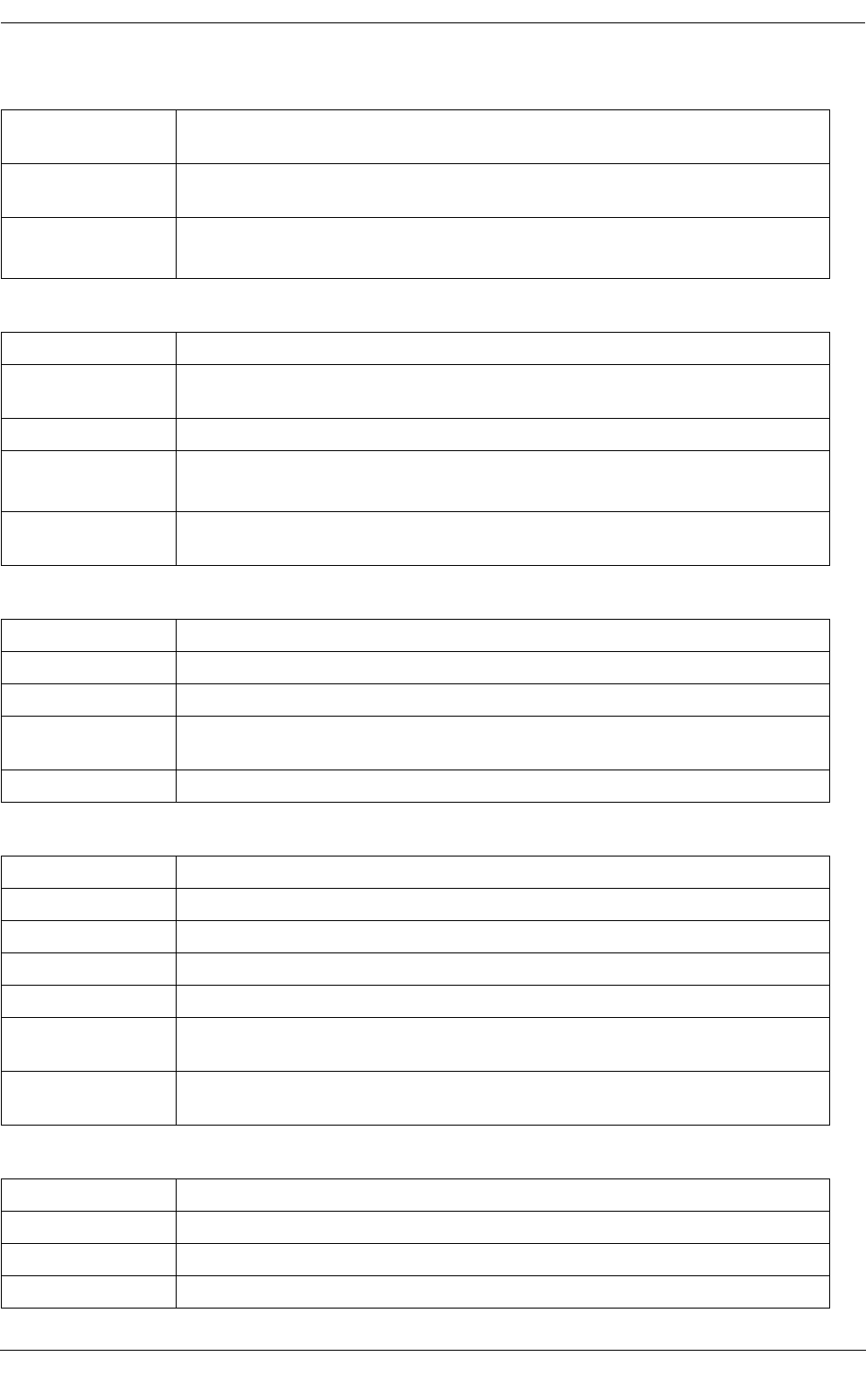
Technical specification
Page 60
11.2.3 Electrical
11.2.4 Internal GPS
11.2.5 TDMA transmitter
11.2.6 TDMA receivers
11.2.7 Supported AIS messages (transmission)
Nominal supply
voltage
12 to 24VDC
Absolute min and
max supply voltages
10 to 32VDC
Power consumption
at 12VDC supply
Type 1 (FATDMA) with message #21 transmission every 3 minutes, 0.1Ah/day
Type 3 (RATDMA) with message #21 transmission every 3 minutes, 1.0AH/day
Receiver channels 50
Time to first fix (cold
start)
<36 seconds
Frequency L1 band, 1575.42MHz
Accuracy 2.5m CEP / 5.0m SEP without differential correction
2.0m CEP / 3.0m SEP with SBAS or RTCM DGPS correction
Antenna
requirement
Internal antenna or active external antenna (3.3V bias) with gain >20dB
Frequency range 156.025MHz to 162.025MHz
Channel bandwidth 25kHz
Output power Configurable 1W, 2W, 5W or 12.5W
Data transmission
rate
9600 bits/s
Modulation mode 25kHz GMSK
Number of receivers 2
Frequency range 156.025MHz to 162.025MHz
Channel bandwidth 25kHz
Sensitivity <-107dBm for 20% PER
Modulation mode 25kHz GMSK
Adjacent channel
sensitivity
70dB
Spurious response
rejection
70dB
Message #6 Binary data for addressed communication
Message #8 Binary data for broadcast communication
Message #12 Safety related data for addressed communication
Message #14 Safety related data for broadcast communication
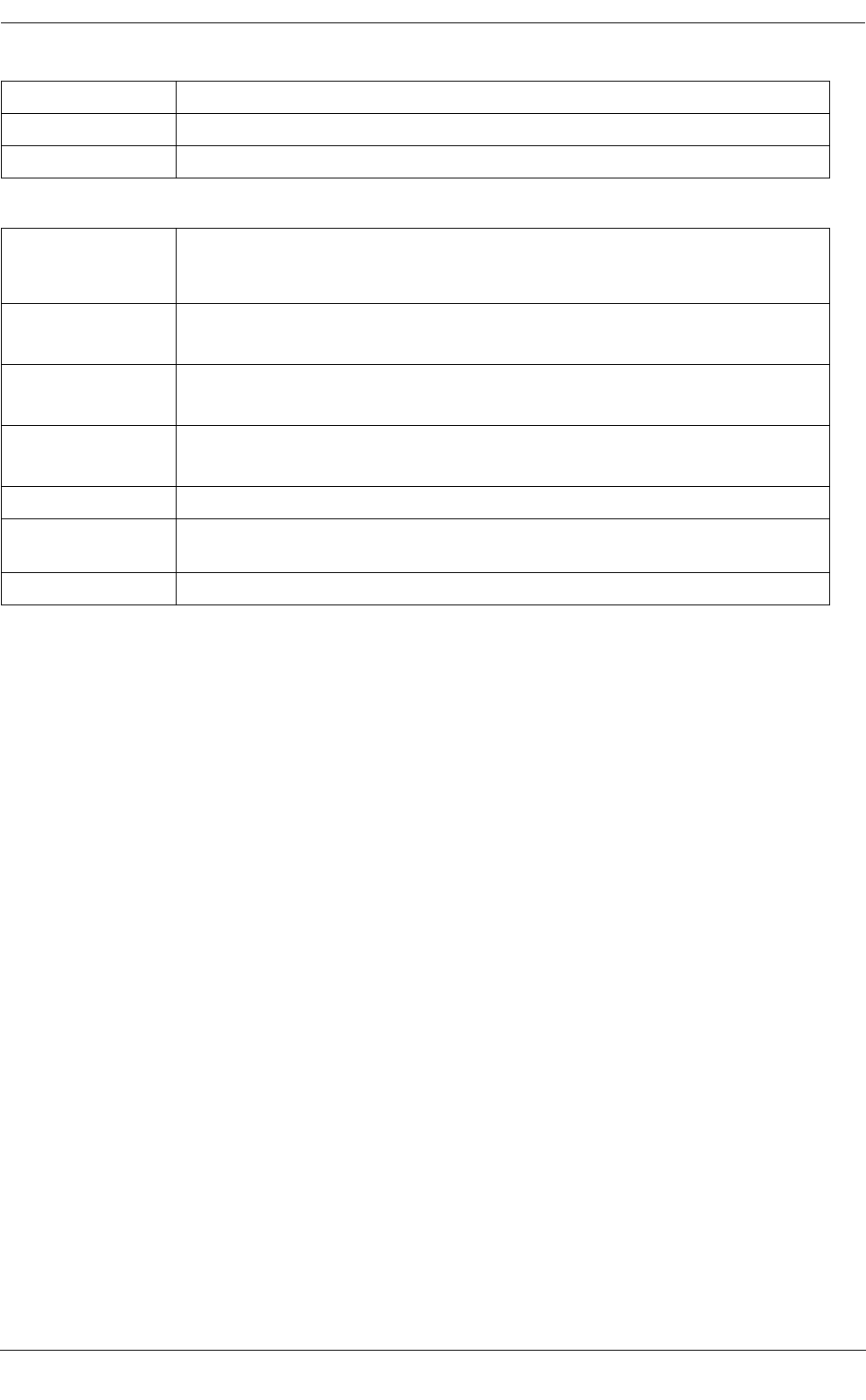
Technical specification
Page 61
11.2.8 Connector types
Message #21 Position and status report for aids-to-navigation
Message #25 Short unscheduled binary data transmission (Broadcast or addressed)
Message #26 Scheduled binary data transmission (Broadcast or addressed)
Power and basic
transceiver
interfaces
Souriau UTS714D19PW32 with type W keying.
Mating half UTS6JC14E19SW.
USB configuration Souriau UTS78D4P32
Mating half is UTS6JC8E4S.
Extended sensor
interfaces A
Souriau UTS714D19PW32 with type X keying.
Mating half is UTS6JC14E19SX.
Extended sensor
interfaces B
Souriau UTS714D19PW32 with type Y keying.
Mating half is UTS6JC14E19SY.
VHF antenna Female ‘N’ type co-axial connector.
External GPS
antenna
Female TNC type co-axial connector.
Ground stud M4 threaded stud

Technical specification
Page 62
11.2.9 Transceiver data interfaces
11.2.10Extended sensor interface specification
*Only one RS232 port is available when the SDI-12 interface is enabled.
11.3 Configuration interface specification
The transceiver is configured via a USB interface and compatible Virtual COM Port (VCP) driver. One VCP is
created for the transceiver configuration interface and a second VCP for the extended sensor interface
configuration port (if the extended sensor interface is present). A USB configuration cable is supplied with the
transceiver.
All configuration is performed via the USB VCP using the standardised and proprietary IEC61162 sentences
defined in section 10.2.
USB USB interface for configuration and diagnostics
NMEA0183 /
IEC61162 / RS422
1x bi-directional RS422 level interface carrying IEC61162 sentences for
configuration, diagnostics and sensor data interface (receiver optically isolated)
1x input only RS422 level interface configuration and sensor data interface
(optically isolated)
Non-isolated digital
I/O
6x 3.3V logic level I/O signals, Inputs 0 – 3 mapped to AtoN status bits in message
#21.
USB USB interface for configuration and diagnostics
RS232 Two RS232 level interfaces for connection of external equipment*
NMEA0183 /
IEC61162 / RS422
One fully optically isolated RS422 level interface for connection of external
equipment
SDI-12 One SDI-12 compliant interface for connection of external sensors supporting the
SDI-12 protocol*
Non-isolated digital
I/O
5x non-isolated logic level I/O signals (3.3V logic levels)
Isolated digital
inputs
5x optically isolated digital inputs, sensitivity 2.5V, max input voltage ±15V.
Isolated analogue
inputs
Two isolated analogue inputs.
Range ±13.75V, 16 bit resolution.
Non-isolated
analogue inputs
Three non-isolated analogue inputs.
Range ±37.2V, 12 bit resolution.
Current sense loop Lamp current sense loop, max 5A. Measurement of currents up to 0.5A with 12bit
resolution.
Relay drive 2x relay driver outputs, max load 200mA at 60VDC.
T1+S
T3+S

Technical specification
Page 63
11.4 Drawings and dimensions
Figure 24 Transceiver mounting bracket dimensions
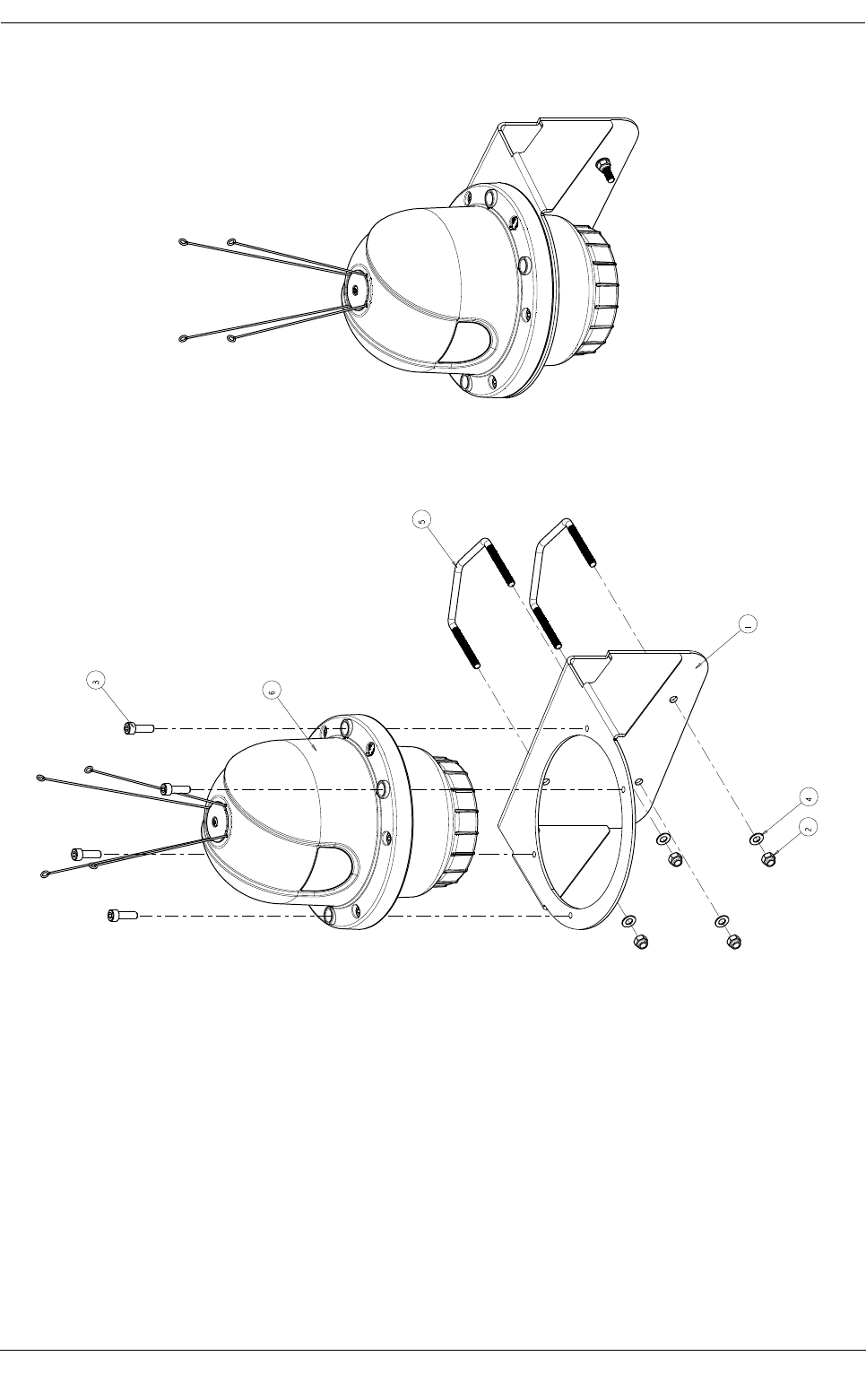
Technical specification
Page 64
Figure 25 Transceiver general assembly
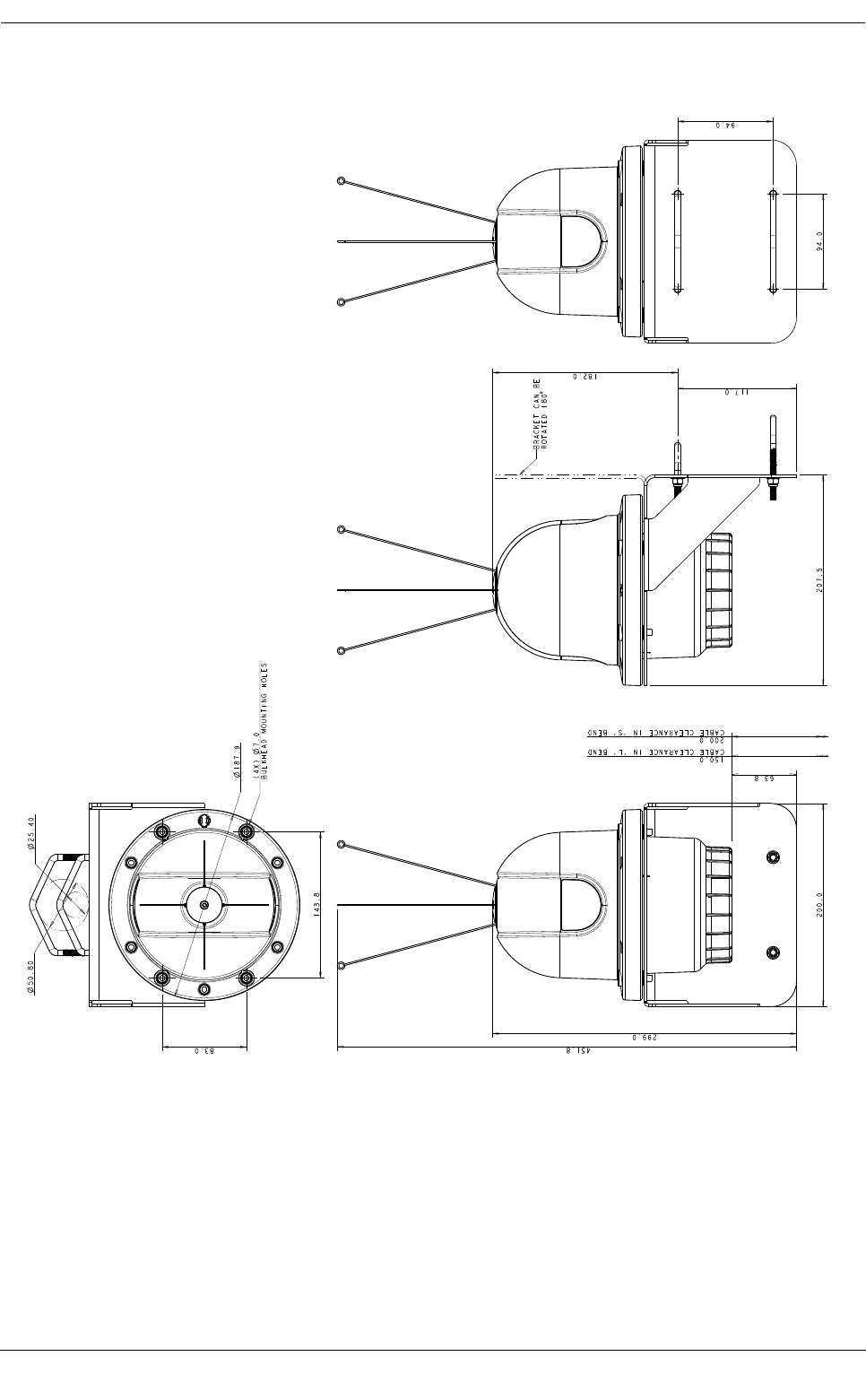
Technical specification
Page 65
Figure 26 Transceiver dimensions
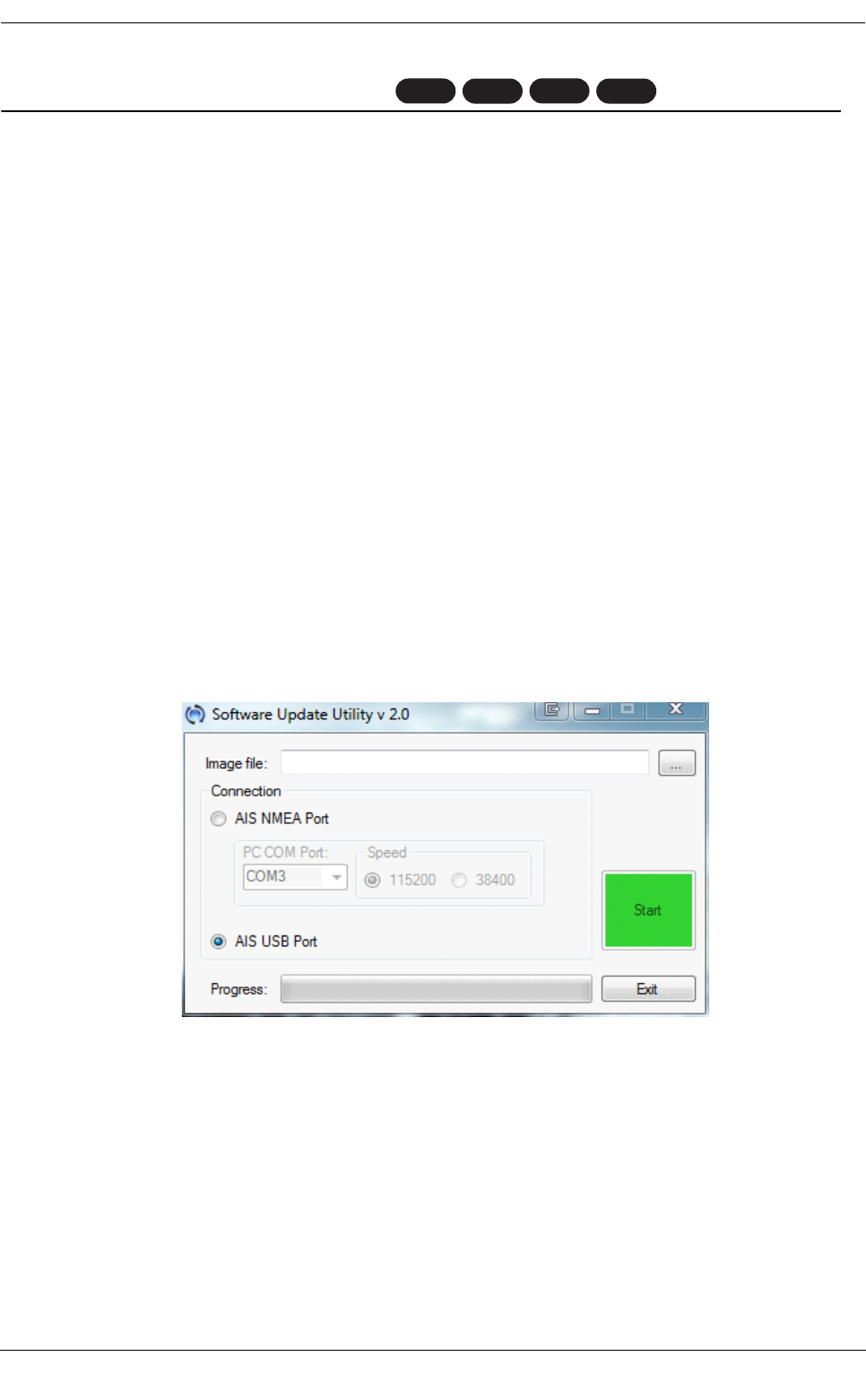
Firmware upgrade procedure
Page 66
12 Firmware upgrade procedure
The transceiver firmware can be updated should a new version be made available. The firmware update is
transferred to the transceiver using the USB interface. The pre-requisites for carrying out a firmware update
are:
●AIS AtoN Transceiver, connected to a 12 or 24V power supply. The power supply must not be
interrupted during the software update.
●The USB configuration cable supplied with the AIS AtoN transceiver
●A PC running Windows (XP, Vista, Windows 7) with a spare USB port
●Prior installation of the USB driver for the AIS AtoN transceiver.
●A software update file for the AIS AtoN transceiver (available from your supplier)
●The 'vxsend' PC software update utility (available from your supplier)
To update the firmware carry out the following steps:
1. Apply power to the transceiver and connect the USB configuration cable to the transceiver and PC
2. Install and run the 'vxsend' utility (screenshot shown in Figure 27)
3. Click the Browse (…) button for the Image file, then navigate to and select the appropriate update file.
4. Select the 'AIS NMEA Port' option and the virtual COM port associated with the transceiver. Do not
select the ‘AIS USB Port’ option.
5. Select the 115200 baud rate option
6. Click 'Start' and wait for the update to complete. Notification is given when the update has completed
successfully.
7. Power cycle the transceiver and confirm normal operation before it is deployed.
Figure 27 vxsend utility screenshot
T1 T1+S
T3
T3+S

Firmware upgrade procedure
Page 67

201-0211:2